Paul van Yperen's Blog, page 188
August 8, 2020
Dana Andrews
American film actor Dana Andrews (1909-1992) was a major Hollywood star during the 1940s. He continued acting in less prestigious roles into the 1980s. He is remembered for his roles as a police detective-lieutenant in the Film Noir Laura (1944) and as war veteran Fred Derry in The Best Years of Our Lives (1946), the latter being the role for which he received the most critical praise. During his career, he worked with such directors as Otto Preminger, Fritz Lang, William Wyler, Jean Renoir, and Elia Kazan.

Italian postcard by Bromofoto, Milano, no. 250. Photo: RKO Radio Films. Dana Andrews in Deep Waters (Henry King, 1948).

Uruguayan postcard by CF. Photo: RKO Radio Films.
An innocent lynching victim
Carver Dana Andrews was born on a farmstead near Collins in southern Mississippi in Covington County in 1909. He was the third of 13 children of Charles Forrest Andrews, a Baptist minister, and his wife, the former Annis Speed. The family relocated subsequently to Huntsville in Walker County, Texas, the birthplace of his younger siblings, including future Hollywood actor Steve Forrest.
Andrews attended college at Sam Houston State University in Huntsville and studied business administration in Houston. He left school in 1929 to take a job as an accountant with the Texas oil company Gulf. In 1931, at the height of the Great Depression, he quit his job, and hitchhiked to Los Angeles, hoping to break into show business.
He worked in various jobs, such as working at a gas station in the nearby community of Van Nuys. To help Andrews study music at night, the station owners stepped in ... with a deal: $50 a week for full-time study, in exchange for a five-year share of possible later earnings. Andrews studied opera and also entered the Pasadena Community Playhouse, the famed theatre company, and drama school. He appeared in scores of plays there in the 1930s, becoming a favourite of the company. He played opposite future star Robert Preston in a play about composers Gilbert and Sullivan, and soon thereafter was offered a contract by Samuel Goldwyn. Andrews signed the contract, but it still took two years before Goldwyn and 20th Century-Fox to whom Goldwyn had sold half of Andrews' contract had work for him.
Finally, nine years after arriving in Los Angeles, he made his film debut at 20th Century Fox in Lucky Cisco Kid (H. Bruce Humberstone, 1940) starring Cesar Romero. He was in Sailor's Lady (Allan Dwan, 1940), developed by Goldwyn but sold to Fox. Andrews was loaned to Edward Small to appear in Kit Carson (George B. Seitz, 1940) before Goldwyn used him for the first time in a Goldwyn production: William Wyler's The Westerner (1940), featuring Gary Cooper . Andrews had support parts in Fox films Tobacco Road (1941), directed by John Ford; Belle Starr (Irving Cummings, 1941), with Gene Tierney , billed third; and Swamp Water (1941), directed by Jean Renoir. His next film for Goldwyn was the comedy Ball of Fire (Billy Wilder, 1941), again teaming with Cooper, where Andrews played a gangster.
Back at Fox, Andrews was given his first lead, in the B-movie Berlin Correspondent (Eugene Forde, 1942). He was second lead to Tyrone Power in Crash Dive (Archie Mayo, 1943) and then appeared in the film adaptation of The Ox-Bow Incident (William A. Wellman, 1943) with Henry Fonda . He played an innocent lynching victim, a role often cited as one of his best. Andrews then went back to Goldwyn for The North Star (Lewis Milestone, 1943). He worked on a government propaganda film December 7th: The Movie (John Ford, Gregg Toland, 1943), then was used by Goldwyn again in Up in Arms (Elliott Nugent, 1944), supporting Danny Kaye . Andrews was reunited with Milestone at Fox for The Purple Heart (Lewis Milestone, 1944), then was in Wing and a Prayer (Henry Hathaway, 1944).

Dutch postcard by Fotoarchief Film en Toneel, no. 3503. Photo: 20th Century Fox.

Dutch postcard, no. a.x. 230. Photo: RKO Radio Films.
A laconic city detective
One of Dana Andrews's famous roles was as a detective in Laura (Otto Preminger, 1944) with Gene Tierney at Fox. His matter-of-fact, deadpan acting style was perfectly suited to laconic city detective Mark McPherson. The Los Angeles Times: "The story of a cynical detective falling in love with a portrait of a supposed murder victim became a classic and seemed to vault Dana Andrews to a level of stardom that he would inhabit for the rest of his career."
He co-featured with Jeanne Crain in the musical State Fair (Walter Lang, 1945), a huge hit, and was reunited with Preminger for Fallen Angel (Otto Preminger, 1945). In 1946, he co-featured with Susan Hayward in an excellent Western, Canyon Passage (Jacques Tourneur, 1946). Andrews did another war film with Milestone, A Walk in the Sun (Lewis Milestone, 1945), then was loaned to Walter Wanger for a Western, Canyon Passage (Jacques Tourneur, 1946).
Andrews's second film with William Wyler, also for Goldwyn, was his most successful: The Best Years of Our Lives (William Wyler, 1946). It was both a popular and critical success with seven Oscars and became the role for which Andrews is best known. Andrews appeared in Boomerang! (1947), directed by Elia Kazan; opposite Merle Oberon in Night Song (John Cromwell, 1947), at RKO; and in Daisy Kenyon (Otto Preminger, 1947).
In 1947, he was voted the 23rd most popular actor in the U.S. Andrews starred in the anti-communist The Iron Curtain (William A. Wellman, 1948), reuniting him with Gene Tierney, then Deep Waters (1948). He made the comedy No Minor Vices (Lewis Milestone, 1948), then went to England for Britannia Mews (Jean Negulesco, 1949). Andrews went to Universal for Sword in the Desert (George Sherman, 1949), then Goldwyn called him back for My Foolish Heart (Mark Robson, 1949) with Susan Hayward . He also played a brutal police officer in Where the Sidewalk Ends (Otto Preminger, 1950), also with Tierney.
Around this time, alcoholism began to damage Andrews's career, and on two occasions it nearly cost him his life as he drove a car. Edge of Doom (Mark Robson, 1950) for Goldwyn was a flop. He went to RKO to make Sealed Cargo (Alfred L. Werker, 1951) which was the only film he made with his brother, Steve Forrest. At Fox, he was in The Frogmen (Lloyd Bacon, 1951). Goldwyn cast him in I Want You (Mark Robson, 1951), an unsuccessful attempt to repeat the success of The Best Years of Our Lives. From 1952 to 1954, Andrews was featured in the radio series, 'I Was a Communist for the FBI', about the experiences of Matt Cvetic, an FBI informant who infiltrated the Communist Party of the United States of America.

French postcard by Editions P.I., Paris, no. 676. Photo: Universal.

Publicity still by Goldwyn Production / RKO Radio Pictures. Farley Granger and Dana Andrews in Edge of Doom (Mark Robson, 1950).
A young hero who no longer looked the part
Dana Andrews's film career struggled in the 1950s. In 1952, with his studio contracts expired, he began to free-lance and formed his own production company, Lawrence Productions. Assignment: Paris (Robert Parrish, 1952) was not widely seen. He did Elephant Walk (William Dieterle, 1954) in Ceylon, a film better known for Vivien Leigh 's nervous breakdown and replacement by Elizabeth Taylor .
Duel in the Jungle (George Marshall, 1954) was an adventure tale; Three Hours to Kill (Alfred L. Werker, 1954) and Smoke Signal (Jerry Hopper, 1955) were Westerns; Strange Lady in Town (Mervyn LeRoy, 1955) was a Greer Garson vehicle; Comanche (George Sherman, 1956), another Western. By the middle 1950s, Andrews was acting almost exclusively in B-movies.
However, his acting in two films for Fritz Lang during 1956, While The City Sleeps and Beyond A Reasonable Doubt, and two for Jacques Tourneur, Curse of the Demon (1957) and The Fearmakers (1958), is well regarded. Around this time he also appeared in Spring Reunion (Robert Pirosh, 1957), Zero Hour! (Hall Bartlett, 1957), and Enchanted Island (Allan Dwan, 1958).
By the late 1950s, work was increasingly harder to get. He was typed in films as a young hero, but he no longer looked the part. His hair was turning white. In 1952, Andrews had toured with his wife, Mary Todd, in 'The Glass Menagerie', and in 1958, he replaced Henry Fonda on Broadway in 'Two for the Seesaw'. He stayed in the play for a year, co-starring with Anne Bancroft. It briefly revitalised his career. Andrews began appearing on television on such shows as Playhouse 90, General Electric Theatre, The Barbara Stanwyck Show, The Twilight Zone, and The Dick Powell Theatre. He also continued to make films like Madison Avenue (H. Bruce Humberstone, 1961). He went to Broadway for 'The Captains and the Kings', which had a short run in 1962.
In 1963, he was elected president of the Screen Actors Guild. In 1965, Andrews resumed film work with supporting roles in The Satan Bug (John Sturges, 1965) and In Harm's Way (Otto Preminger, 1965). He also had the lead in Crack in the World (Andrew Marton, 1965), and Brainstorm (William Conrad, 1965). However, he was cast increasingly in supporting roles: such as in the Eurospy film Berlino appuntamento per le spie (Operazione Polifemo)/Berlin, Appointment for the Spies (Vittorio Sala, 1965), The Loved One (Tony Richardson, 1965), and Battle of the Bulge (Ken Annakin, 1965) starring Henry Fonda .
Andrews still played leads in low-budget films like Hot Rods to Hell (John Brahm, 1967). By this time, Andrews had evolved into a character actor, as in the war film The Devil's Brigade (Andrew V. McLaglen, 1968) and the Italian production I diamanti che nessuno voleva rubare/No Diamonds for Ursula (Gino Mangini, 1967). Later, Andrews returned to the leading role of college president Tom Boswell on the soap opera Bright Promise (1969-1971).

Dutch postcard by Takken, Utrecht, no. 3532. Photo: RKO Radio Films Foto archief: Film en Toneel.

Vintage postcard. Photo: RKO Radio Films.
Controlling his alcoholism
Dana Andrews' increasing alcoholism caused him to lose the confidence of some producers. Andrews took steps to curb his addiction and eventually controlled his alcoholism. He worked actively with the National Council on Alcoholism and Drug Dependence and appeared in a television public service advertisement concerning the subject in 1972.
Andrews spent the 1970s in supporting Hollywood roles such as The Last Tycoon (Elia Kazan, 1976) starring Robert de Niro , and the TV film The Last Hurrah (Vincent Sherman, 1977), with Carroll O'Connor. He also appeared regularly on TV in such shows as Ironside, Get Christie Love!, Ellery Queen, The American Girls, The Hardy Boys/Nancy Drew Mysteries, and The Love Boat.
It was at this time, the 1970s, that Andrews became involved in the real estate business. Andrews's final roles included the Mini-series Ike: The War Years (Boris Sagal, Melville Shavelson, 1979) in which he played General George C. Marshall, The Pilot (Cliff Robertson, 1980), and the soap opera Falcon Crest (1982-1983). His last film was Prince Jack (Bert Lovitt, 1985).
Andrews had married Janet Murray in 1932. Murray died in 1935 as a result of pneumonia. Their son, David (1933–1964), was a musician and composer who died from a cerebral hemorrhage. In 1939, Andrews married a Pasadena Playhouse actress, Mary Todd, by whom he had three children: Katharine, Stephen, and Susan. For two decades, the family lived in Toluca Lake, California.
During the last years of his life, Andrews suffered from Alzheimer's disease. He spent his final years living at the John Douglas French Center for Alzheimer's Disease in Los Alamitos, California. On 17 December 1992, 15 days before his 84th birthday, Andrews died of congestive heart failure and pneumonia. His wife died in 2003 at the age of 86.

Dutch postcard, no. 395. Photo: Universal International. Dana Andrews in Sword in the Desert (George Sherman, 1949).

Belgian card, no. 850. Photo: R.K.O. Susan Hayward and Dana Andrews in My Foolish Heart (Mark Robson, 1949).
Trailer Laura (1944). Source: BFI Trailers (YouTube).
Source: Hal Erickson (AllMovie), Los Angeles Times, Wikipedia, and .

Italian postcard by Bromofoto, Milano, no. 250. Photo: RKO Radio Films. Dana Andrews in Deep Waters (Henry King, 1948).

Uruguayan postcard by CF. Photo: RKO Radio Films.
An innocent lynching victim
Carver Dana Andrews was born on a farmstead near Collins in southern Mississippi in Covington County in 1909. He was the third of 13 children of Charles Forrest Andrews, a Baptist minister, and his wife, the former Annis Speed. The family relocated subsequently to Huntsville in Walker County, Texas, the birthplace of his younger siblings, including future Hollywood actor Steve Forrest.
Andrews attended college at Sam Houston State University in Huntsville and studied business administration in Houston. He left school in 1929 to take a job as an accountant with the Texas oil company Gulf. In 1931, at the height of the Great Depression, he quit his job, and hitchhiked to Los Angeles, hoping to break into show business.
He worked in various jobs, such as working at a gas station in the nearby community of Van Nuys. To help Andrews study music at night, the station owners stepped in ... with a deal: $50 a week for full-time study, in exchange for a five-year share of possible later earnings. Andrews studied opera and also entered the Pasadena Community Playhouse, the famed theatre company, and drama school. He appeared in scores of plays there in the 1930s, becoming a favourite of the company. He played opposite future star Robert Preston in a play about composers Gilbert and Sullivan, and soon thereafter was offered a contract by Samuel Goldwyn. Andrews signed the contract, but it still took two years before Goldwyn and 20th Century-Fox to whom Goldwyn had sold half of Andrews' contract had work for him.
Finally, nine years after arriving in Los Angeles, he made his film debut at 20th Century Fox in Lucky Cisco Kid (H. Bruce Humberstone, 1940) starring Cesar Romero. He was in Sailor's Lady (Allan Dwan, 1940), developed by Goldwyn but sold to Fox. Andrews was loaned to Edward Small to appear in Kit Carson (George B. Seitz, 1940) before Goldwyn used him for the first time in a Goldwyn production: William Wyler's The Westerner (1940), featuring Gary Cooper . Andrews had support parts in Fox films Tobacco Road (1941), directed by John Ford; Belle Starr (Irving Cummings, 1941), with Gene Tierney , billed third; and Swamp Water (1941), directed by Jean Renoir. His next film for Goldwyn was the comedy Ball of Fire (Billy Wilder, 1941), again teaming with Cooper, where Andrews played a gangster.
Back at Fox, Andrews was given his first lead, in the B-movie Berlin Correspondent (Eugene Forde, 1942). He was second lead to Tyrone Power in Crash Dive (Archie Mayo, 1943) and then appeared in the film adaptation of The Ox-Bow Incident (William A. Wellman, 1943) with Henry Fonda . He played an innocent lynching victim, a role often cited as one of his best. Andrews then went back to Goldwyn for The North Star (Lewis Milestone, 1943). He worked on a government propaganda film December 7th: The Movie (John Ford, Gregg Toland, 1943), then was used by Goldwyn again in Up in Arms (Elliott Nugent, 1944), supporting Danny Kaye . Andrews was reunited with Milestone at Fox for The Purple Heart (Lewis Milestone, 1944), then was in Wing and a Prayer (Henry Hathaway, 1944).

Dutch postcard by Fotoarchief Film en Toneel, no. 3503. Photo: 20th Century Fox.

Dutch postcard, no. a.x. 230. Photo: RKO Radio Films.
A laconic city detective
One of Dana Andrews's famous roles was as a detective in Laura (Otto Preminger, 1944) with Gene Tierney at Fox. His matter-of-fact, deadpan acting style was perfectly suited to laconic city detective Mark McPherson. The Los Angeles Times: "The story of a cynical detective falling in love with a portrait of a supposed murder victim became a classic and seemed to vault Dana Andrews to a level of stardom that he would inhabit for the rest of his career."
He co-featured with Jeanne Crain in the musical State Fair (Walter Lang, 1945), a huge hit, and was reunited with Preminger for Fallen Angel (Otto Preminger, 1945). In 1946, he co-featured with Susan Hayward in an excellent Western, Canyon Passage (Jacques Tourneur, 1946). Andrews did another war film with Milestone, A Walk in the Sun (Lewis Milestone, 1945), then was loaned to Walter Wanger for a Western, Canyon Passage (Jacques Tourneur, 1946).
Andrews's second film with William Wyler, also for Goldwyn, was his most successful: The Best Years of Our Lives (William Wyler, 1946). It was both a popular and critical success with seven Oscars and became the role for which Andrews is best known. Andrews appeared in Boomerang! (1947), directed by Elia Kazan; opposite Merle Oberon in Night Song (John Cromwell, 1947), at RKO; and in Daisy Kenyon (Otto Preminger, 1947).
In 1947, he was voted the 23rd most popular actor in the U.S. Andrews starred in the anti-communist The Iron Curtain (William A. Wellman, 1948), reuniting him with Gene Tierney, then Deep Waters (1948). He made the comedy No Minor Vices (Lewis Milestone, 1948), then went to England for Britannia Mews (Jean Negulesco, 1949). Andrews went to Universal for Sword in the Desert (George Sherman, 1949), then Goldwyn called him back for My Foolish Heart (Mark Robson, 1949) with Susan Hayward . He also played a brutal police officer in Where the Sidewalk Ends (Otto Preminger, 1950), also with Tierney.
Around this time, alcoholism began to damage Andrews's career, and on two occasions it nearly cost him his life as he drove a car. Edge of Doom (Mark Robson, 1950) for Goldwyn was a flop. He went to RKO to make Sealed Cargo (Alfred L. Werker, 1951) which was the only film he made with his brother, Steve Forrest. At Fox, he was in The Frogmen (Lloyd Bacon, 1951). Goldwyn cast him in I Want You (Mark Robson, 1951), an unsuccessful attempt to repeat the success of The Best Years of Our Lives. From 1952 to 1954, Andrews was featured in the radio series, 'I Was a Communist for the FBI', about the experiences of Matt Cvetic, an FBI informant who infiltrated the Communist Party of the United States of America.

French postcard by Editions P.I., Paris, no. 676. Photo: Universal.

Publicity still by Goldwyn Production / RKO Radio Pictures. Farley Granger and Dana Andrews in Edge of Doom (Mark Robson, 1950).
A young hero who no longer looked the part
Dana Andrews's film career struggled in the 1950s. In 1952, with his studio contracts expired, he began to free-lance and formed his own production company, Lawrence Productions. Assignment: Paris (Robert Parrish, 1952) was not widely seen. He did Elephant Walk (William Dieterle, 1954) in Ceylon, a film better known for Vivien Leigh 's nervous breakdown and replacement by Elizabeth Taylor .
Duel in the Jungle (George Marshall, 1954) was an adventure tale; Three Hours to Kill (Alfred L. Werker, 1954) and Smoke Signal (Jerry Hopper, 1955) were Westerns; Strange Lady in Town (Mervyn LeRoy, 1955) was a Greer Garson vehicle; Comanche (George Sherman, 1956), another Western. By the middle 1950s, Andrews was acting almost exclusively in B-movies.
However, his acting in two films for Fritz Lang during 1956, While The City Sleeps and Beyond A Reasonable Doubt, and two for Jacques Tourneur, Curse of the Demon (1957) and The Fearmakers (1958), is well regarded. Around this time he also appeared in Spring Reunion (Robert Pirosh, 1957), Zero Hour! (Hall Bartlett, 1957), and Enchanted Island (Allan Dwan, 1958).
By the late 1950s, work was increasingly harder to get. He was typed in films as a young hero, but he no longer looked the part. His hair was turning white. In 1952, Andrews had toured with his wife, Mary Todd, in 'The Glass Menagerie', and in 1958, he replaced Henry Fonda on Broadway in 'Two for the Seesaw'. He stayed in the play for a year, co-starring with Anne Bancroft. It briefly revitalised his career. Andrews began appearing on television on such shows as Playhouse 90, General Electric Theatre, The Barbara Stanwyck Show, The Twilight Zone, and The Dick Powell Theatre. He also continued to make films like Madison Avenue (H. Bruce Humberstone, 1961). He went to Broadway for 'The Captains and the Kings', which had a short run in 1962.
In 1963, he was elected president of the Screen Actors Guild. In 1965, Andrews resumed film work with supporting roles in The Satan Bug (John Sturges, 1965) and In Harm's Way (Otto Preminger, 1965). He also had the lead in Crack in the World (Andrew Marton, 1965), and Brainstorm (William Conrad, 1965). However, he was cast increasingly in supporting roles: such as in the Eurospy film Berlino appuntamento per le spie (Operazione Polifemo)/Berlin, Appointment for the Spies (Vittorio Sala, 1965), The Loved One (Tony Richardson, 1965), and Battle of the Bulge (Ken Annakin, 1965) starring Henry Fonda .
Andrews still played leads in low-budget films like Hot Rods to Hell (John Brahm, 1967). By this time, Andrews had evolved into a character actor, as in the war film The Devil's Brigade (Andrew V. McLaglen, 1968) and the Italian production I diamanti che nessuno voleva rubare/No Diamonds for Ursula (Gino Mangini, 1967). Later, Andrews returned to the leading role of college president Tom Boswell on the soap opera Bright Promise (1969-1971).

Dutch postcard by Takken, Utrecht, no. 3532. Photo: RKO Radio Films Foto archief: Film en Toneel.

Vintage postcard. Photo: RKO Radio Films.
Controlling his alcoholism
Dana Andrews' increasing alcoholism caused him to lose the confidence of some producers. Andrews took steps to curb his addiction and eventually controlled his alcoholism. He worked actively with the National Council on Alcoholism and Drug Dependence and appeared in a television public service advertisement concerning the subject in 1972.
Andrews spent the 1970s in supporting Hollywood roles such as The Last Tycoon (Elia Kazan, 1976) starring Robert de Niro , and the TV film The Last Hurrah (Vincent Sherman, 1977), with Carroll O'Connor. He also appeared regularly on TV in such shows as Ironside, Get Christie Love!, Ellery Queen, The American Girls, The Hardy Boys/Nancy Drew Mysteries, and The Love Boat.
It was at this time, the 1970s, that Andrews became involved in the real estate business. Andrews's final roles included the Mini-series Ike: The War Years (Boris Sagal, Melville Shavelson, 1979) in which he played General George C. Marshall, The Pilot (Cliff Robertson, 1980), and the soap opera Falcon Crest (1982-1983). His last film was Prince Jack (Bert Lovitt, 1985).
Andrews had married Janet Murray in 1932. Murray died in 1935 as a result of pneumonia. Their son, David (1933–1964), was a musician and composer who died from a cerebral hemorrhage. In 1939, Andrews married a Pasadena Playhouse actress, Mary Todd, by whom he had three children: Katharine, Stephen, and Susan. For two decades, the family lived in Toluca Lake, California.
During the last years of his life, Andrews suffered from Alzheimer's disease. He spent his final years living at the John Douglas French Center for Alzheimer's Disease in Los Alamitos, California. On 17 December 1992, 15 days before his 84th birthday, Andrews died of congestive heart failure and pneumonia. His wife died in 2003 at the age of 86.

Dutch postcard, no. 395. Photo: Universal International. Dana Andrews in Sword in the Desert (George Sherman, 1949).

Belgian card, no. 850. Photo: R.K.O. Susan Hayward and Dana Andrews in My Foolish Heart (Mark Robson, 1949).
Trailer Laura (1944). Source: BFI Trailers (YouTube).
Source: Hal Erickson (AllMovie), Los Angeles Times, Wikipedia, and .
Published on August 08, 2020 22:00
August 7, 2020
The Cinema of Jan Vanderheyden
Outside of Belgium, little is known about the history of the Flemish cinema. The first Flemish sound film, De Witte/Whitey (1934) was an enormous success. The film's director, Jan Vanderheyden, and his wife, German scriptwriter Edith Kiel, made a series of popular folk comedies during the 1930s and early 1940s. The young star of De Witte, Jef Bruyninckx, grew up in their films. Lately, we found a series of rare postcards of the 1940s with some of the stars of the Jan Vanderheyden films.

Belgian postcard by Esclamator. Photo: Jan Vanderheyden-Film. Jef Bruyninckx in De Witte/Whitey (Jan Vanderheyden, 1934), based on the eponymous novel by Ernest Claes. In 1980 a new adaptation by Robbe De Hert would follow.
Jef Bruyninckx (1919-1995) was an important and popular Flemish actor and film and television director. He was one of the founders of both Flemish film production and Flemish television, in which he continued to play an important role later. Bruyninckx was also an editor and taught editing at the Royal Academy of Fine Arts in Ghent.

Belgian postcard by Huis Ern. Thill, Brussel (Brussels). Photo: Jan Vanderheyden-Film.
Nini de Boël (1898-1982) was a Flemish actress and soprano who was known as the 'Antwerp Nightingale'. She starred in many revues and operettas in the first half of the 20th century, and also appeared in several Flemish films, including the comedy Janssens tegen Peeters/Janssens against Peeters (Jan Vanderheyden, 1939).

Belgian postcard by Huis Ern. Thill, Brussel (Brussels). Photo: Jan Vanderheyden-Film.
René Bertal (1898-1962) was a Belgian actor who acted in Flemish folk films of the 1930s, 1940s, and 1950s. Bertal played the title role in the comedy Antoon, de flierefluiter/Anton, the Village Casanova (Jan Vanderheyden, 1942) with Nand Buyl. After this feature, he appeared in two shorts, the escapist musical short film Muziek is schoon/Music is beautiful (Jan Vanderheyden, 1943), and Een zondags uitstapje/A Trip on Sunday (Jan Vanderheyden, 1943).

Belgian postcard by Huis Ern. Thill, Brussel (Brussels). Photo: Jan Vanderheyden-Film.
Belgian actress Martha Dua is known for three Vanderheyden films: the comedy Janssens tegen Peeters/Janssens against Peeters (Jan Vanderheyden, 1939) with Charles Janssens, the sequel Janssens en Peeters dikke vrienden/Janssens and Peeters are close friends (Jan Vanderheyden, 1940) and the soccer comedy Wit is troef/White is Trump (Jan Vanderheyden, 1940).
Jan Vanderheyden
Jan Vanderheyden (1890-1961) was both a film producer and director. He was married to the German filmmaker Edith Kiel, who wrote the scripts for his films.
Their first film, De Witte/Whitey (1934), was also the first Flemish film production with sound. It was also very successful. Weeks after the première in Antwerp's Cinema Colosseum the public kept coming to the picture.
The story describes the boyishnesses of Louis Verheyden (Jef Bruyninckx), a white-haired rascal, nicknamed 'De Witte' (the white one) in Zichem, a village in the countryside. In the film, everything happens from the child's perspective. Edith Kiel added a love story to the original storyline made by Ernest Claes, something the original author did not like. Another adaptation with which the Church instead had difficulties was the minimalised role of the village priest.
In the following years, Vanderheyden and Kiel made such films as Alleen voor U/Only for you (Jan Vanderheyden, 1935), Uilenspiegel leeft nog/Uilenspiegel Still Lives (Jan Vanderheyden, 1935), De wonderdokter/The miracle doctor (Jan Vanderheyden, 1936), Havenmuziek/Music in the Harbour (Jan Vanderheyden, 1937), and Drie flinke kerels/Three good guys (Jan Vanderheyden, 1938). In most of these films, the boys Jef Bruyninckx and Nand Buyl played leading roles.
A huge success was the comedy Janssens tegen Peeters/Janssens against Peeters (Jan Vanderheyden, 1939) starring Charles Janssens, Louisa Lausanne and Jef Bruyninckx. The following year, the sequel Janssens en Peeters dikke vrienden/Janssens and Peeters as good friends (Jan Vanderheyden, 1940) was released.
During the German occupation of Belgium between 1940 and 1944, Vanderheuyden produced four of the six films made by Belgian companies in a market that was otherwise flooded by imported German films. His films included Veel geluk, Monika/Good Luck, Monique! (Jan Vanderheyden, 1941) featuring Louisa Colpeyn, and Antoon, de flierefluiter/Anton, the Village Casanova (Jan Vanderheyden, 1942) with René Bertal.
Vanderheyden hoped to benefit from the Flamenpolitik instituted by the Germans, as Belgian cinema had traditionally been dominated by English and French language films. Vanderheyden made his last film in 1942, after which Belgian feature film production was suspended due to an increasing shortage of film stock.

Belgian postcard by Huis Ern. Thill, Brussel (Brussels). Photo: Jan Vanderheyden-Film.
Flemish actor Antoon Janssens (1866–1958) is better known as Toontje Janssens. He was one of Belgium's most popular comedians. Since 1929, he appeared in several Belgian films including the comedy Janssens tegen Peeters/Janssens against Peeters (Jan Vanderheyden, 1939) in which he played Granddad Peeters, the soccer comedy Wit is troef/White is Trump (Jan Vanderheyden, 1940) with soccer player Raymond Braine, and the sequel Janssens en Peeters dikke vrienden/Janssens and Peeters as good friends (Jan Vanderheyden, 1940).

Belgian postcard by Huis Ern. Thill, Brussel (Brussels). Photo: Jan Vanderheyden-Film.
Louisa Colpeyn (1918-2015) was a Belgian actress, who worked both in the theatre and in the film. In 1942, she moved to Paris. She appeared in more than thirty films from 1939 to 1983, including Janssens tegen Peeters/Janssens against Peeters (Jan Vanderheyden, 1939) and Veel geluk, Monika/Good luck Monique! (Jan Vanderheyden, 1941) in which she played the title role. Her son is the acclaimed author Patrick Modiano.

Belgian postcard by Huis Ern. Thill, Brussel (Brussels). Photo: Jan Vanderheyden-Film.
Fred Engelen (1912-1967) was a celebrated Belgian stage actor and director in Belgium, Germany, and the Netherlands. He also acted in Flemish films such as Met den helm geboren/Born with the helmet (Jan Vanderheyden, 1939), starring Jef Bruyninckx and Nand Buyl, the comedies Janssens tegen Peeters/Janssens against Peeters (Willem Benoy, Jan Vanderheyden, 1939), Een engel van een man/A man like an angel (Jan Vanderheyden, 1939), and Antoon, de flierefluiter/Anton, the Village Casanova (Jan Vanderheyden, 1942).

Belgian postcard by Huis Ern. Thill, Brussel (Brussels). Photo: Jan Vanderheyden-Film.
Jef Bruyninckx (1919-1995) was an important and popular Flemish actor and film and television director. He gained fame through his leading role as De Witte van Zichem in the eponymous Flemish success film De Witte/Whitey by Jan Vanderheyden (1934). In the following series of folk films by Vanderheyden, he also always played one of the main roles. He was one of the founders of both Flemish film production and Flemish television, in which he continued to play an important role later. Bruyninckx was also an editor and taught editing at the Royal Academy of Fine Arts in Ghent.
Sources: Wikipedia and .

Belgian postcard by Esclamator. Photo: Jan Vanderheyden-Film. Jef Bruyninckx in De Witte/Whitey (Jan Vanderheyden, 1934), based on the eponymous novel by Ernest Claes. In 1980 a new adaptation by Robbe De Hert would follow.
Jef Bruyninckx (1919-1995) was an important and popular Flemish actor and film and television director. He was one of the founders of both Flemish film production and Flemish television, in which he continued to play an important role later. Bruyninckx was also an editor and taught editing at the Royal Academy of Fine Arts in Ghent.

Belgian postcard by Huis Ern. Thill, Brussel (Brussels). Photo: Jan Vanderheyden-Film.
Nini de Boël (1898-1982) was a Flemish actress and soprano who was known as the 'Antwerp Nightingale'. She starred in many revues and operettas in the first half of the 20th century, and also appeared in several Flemish films, including the comedy Janssens tegen Peeters/Janssens against Peeters (Jan Vanderheyden, 1939).

Belgian postcard by Huis Ern. Thill, Brussel (Brussels). Photo: Jan Vanderheyden-Film.
René Bertal (1898-1962) was a Belgian actor who acted in Flemish folk films of the 1930s, 1940s, and 1950s. Bertal played the title role in the comedy Antoon, de flierefluiter/Anton, the Village Casanova (Jan Vanderheyden, 1942) with Nand Buyl. After this feature, he appeared in two shorts, the escapist musical short film Muziek is schoon/Music is beautiful (Jan Vanderheyden, 1943), and Een zondags uitstapje/A Trip on Sunday (Jan Vanderheyden, 1943).

Belgian postcard by Huis Ern. Thill, Brussel (Brussels). Photo: Jan Vanderheyden-Film.
Belgian actress Martha Dua is known for three Vanderheyden films: the comedy Janssens tegen Peeters/Janssens against Peeters (Jan Vanderheyden, 1939) with Charles Janssens, the sequel Janssens en Peeters dikke vrienden/Janssens and Peeters are close friends (Jan Vanderheyden, 1940) and the soccer comedy Wit is troef/White is Trump (Jan Vanderheyden, 1940).
Jan Vanderheyden
Jan Vanderheyden (1890-1961) was both a film producer and director. He was married to the German filmmaker Edith Kiel, who wrote the scripts for his films.
Their first film, De Witte/Whitey (1934), was also the first Flemish film production with sound. It was also very successful. Weeks after the première in Antwerp's Cinema Colosseum the public kept coming to the picture.
The story describes the boyishnesses of Louis Verheyden (Jef Bruyninckx), a white-haired rascal, nicknamed 'De Witte' (the white one) in Zichem, a village in the countryside. In the film, everything happens from the child's perspective. Edith Kiel added a love story to the original storyline made by Ernest Claes, something the original author did not like. Another adaptation with which the Church instead had difficulties was the minimalised role of the village priest.
In the following years, Vanderheyden and Kiel made such films as Alleen voor U/Only for you (Jan Vanderheyden, 1935), Uilenspiegel leeft nog/Uilenspiegel Still Lives (Jan Vanderheyden, 1935), De wonderdokter/The miracle doctor (Jan Vanderheyden, 1936), Havenmuziek/Music in the Harbour (Jan Vanderheyden, 1937), and Drie flinke kerels/Three good guys (Jan Vanderheyden, 1938). In most of these films, the boys Jef Bruyninckx and Nand Buyl played leading roles.
A huge success was the comedy Janssens tegen Peeters/Janssens against Peeters (Jan Vanderheyden, 1939) starring Charles Janssens, Louisa Lausanne and Jef Bruyninckx. The following year, the sequel Janssens en Peeters dikke vrienden/Janssens and Peeters as good friends (Jan Vanderheyden, 1940) was released.
During the German occupation of Belgium between 1940 and 1944, Vanderheuyden produced four of the six films made by Belgian companies in a market that was otherwise flooded by imported German films. His films included Veel geluk, Monika/Good Luck, Monique! (Jan Vanderheyden, 1941) featuring Louisa Colpeyn, and Antoon, de flierefluiter/Anton, the Village Casanova (Jan Vanderheyden, 1942) with René Bertal.
Vanderheyden hoped to benefit from the Flamenpolitik instituted by the Germans, as Belgian cinema had traditionally been dominated by English and French language films. Vanderheyden made his last film in 1942, after which Belgian feature film production was suspended due to an increasing shortage of film stock.

Belgian postcard by Huis Ern. Thill, Brussel (Brussels). Photo: Jan Vanderheyden-Film.
Flemish actor Antoon Janssens (1866–1958) is better known as Toontje Janssens. He was one of Belgium's most popular comedians. Since 1929, he appeared in several Belgian films including the comedy Janssens tegen Peeters/Janssens against Peeters (Jan Vanderheyden, 1939) in which he played Granddad Peeters, the soccer comedy Wit is troef/White is Trump (Jan Vanderheyden, 1940) with soccer player Raymond Braine, and the sequel Janssens en Peeters dikke vrienden/Janssens and Peeters as good friends (Jan Vanderheyden, 1940).

Belgian postcard by Huis Ern. Thill, Brussel (Brussels). Photo: Jan Vanderheyden-Film.
Louisa Colpeyn (1918-2015) was a Belgian actress, who worked both in the theatre and in the film. In 1942, she moved to Paris. She appeared in more than thirty films from 1939 to 1983, including Janssens tegen Peeters/Janssens against Peeters (Jan Vanderheyden, 1939) and Veel geluk, Monika/Good luck Monique! (Jan Vanderheyden, 1941) in which she played the title role. Her son is the acclaimed author Patrick Modiano.

Belgian postcard by Huis Ern. Thill, Brussel (Brussels). Photo: Jan Vanderheyden-Film.
Fred Engelen (1912-1967) was a celebrated Belgian stage actor and director in Belgium, Germany, and the Netherlands. He also acted in Flemish films such as Met den helm geboren/Born with the helmet (Jan Vanderheyden, 1939), starring Jef Bruyninckx and Nand Buyl, the comedies Janssens tegen Peeters/Janssens against Peeters (Willem Benoy, Jan Vanderheyden, 1939), Een engel van een man/A man like an angel (Jan Vanderheyden, 1939), and Antoon, de flierefluiter/Anton, the Village Casanova (Jan Vanderheyden, 1942).

Belgian postcard by Huis Ern. Thill, Brussel (Brussels). Photo: Jan Vanderheyden-Film.
Jef Bruyninckx (1919-1995) was an important and popular Flemish actor and film and television director. He gained fame through his leading role as De Witte van Zichem in the eponymous Flemish success film De Witte/Whitey by Jan Vanderheyden (1934). In the following series of folk films by Vanderheyden, he also always played one of the main roles. He was one of the founders of both Flemish film production and Flemish television, in which he continued to play an important role later. Bruyninckx was also an editor and taught editing at the Royal Academy of Fine Arts in Ghent.
Sources: Wikipedia and .
Published on August 07, 2020 22:00
August 6, 2020
Luigi Almirante
Luigi Almirante (1886–1963) was an Italian stage and screen actor. His slender body and his wiry face made him an incisive comic actor. In the 1930s, he established himself at the new Cinecittà studios in the telefoni bianchi films.

Italian postcard by Ed. A Traldi, Milano, no. 44. Photo: Trevisani, Bologna.
Six Characters in Search of an Author
In 1886, Luigi Almirante was born in Tunis, French Protectorate of Tunisia (now Tunisia), where his father's stage company was touring at the time. He was the son of the actor Nunzio Almirante, brother of the actors Ernesto and Giacomo Almirante, and the director Mario Almirante. He was also the nephew of the silent film actress Italia Almirante Manzini.
Luigi Almirante began his career on stage at the age of 14 or 15 (sources differ), reciting small parts in the company of Angelo Pezzaglia. He appeared together with Pezzaglia's young niece Paola Pezzaglia, with whom he would later also work in the company of Dina Galli . Active in humorous roles since 1907, Almirante had his acting breakthrough in 1909 with the 'Grand Guignol' stage company directed by Alfredo Sainati.
During World War I, he served at the Soldier's Theatre in Udine, under Renato Simoni. After the war, he was part of the Antonio Gandusio company for three years, and then joined the Theater Company Niccodemi, staying there until 1923. He obtained a resounding success with the plays by Luigi Pirandello. He was very successful in the drama 'Sei personaggi in cerca d'autore' (Six Characters in Search of an Author), in his first performance at the Teatro Valle in Rome, on 9 May 1921.
In 1926, he made his cinema debut with the silent film La bellezza del mondo/Beauty of the World, directed by Mario Almirante. He starred alongside his aunt Italia. From then on, he also devoted himself to the cinema. With the advent of sound film, he began to emerge in comical roles, favoured by his slender body and his wiry face, which made him an incisive comic actor.
Equipped with a shrill and perfect voice to provoke ironic effects, he was considered one of the best character actors of his time, as demonstrated in the film Il presidente della Ba.Ce.Cre.Mi./The President of the Ba.Ce.Cre.Mi. (Gennaro Righelli, 1933). Also in 1933, he played Francis Flute in 'A Midsummer Night's Dream' by William Shakespeare, directed by Max Reinhardt. In 1935 he was the antiquarian in 'Savonarola' by Rino Alessi, staged at the Piazza della Signoria in Florence.

Italian postcard by Ed. Stab. Capecchi, Livorno, no. 209.

Italian postcard, no. 539. Photo: Scoffone.
Telefoni bianchi at the new Cinecittà studios
In the thirties, Luigi Almirante often acted alongside Eduardo and Peppino De Filippo , Assia Noris , Vivi Gioi , Franco Coop, and Anna Magnani . He established himself at the new Cinecittà studios in the telefoni bianchi films, where he made friends with the greatest Italian directors of the time, such as Carlo Ludovico Bragaglia, Mario Camerini, Mario Bonnard , Guido Brignone, Alberto Lattuada, Carmine Gallone, and Mario Mattoli.
Examples pf his telefoni bianchi are the comedy O la borsa o la vita/Your Money or Your Life (Carlo Ludovico Bragaglia, 1932) with Sergio Tofano, Darò un milione/I'll give a million (Mario Camerini, 1935), with Vittorio De Sica and Assia Noris , and Batticuore/Heartbeat (Mario Camerini, 1939) with, again, Noris, and Maurizio D'Ancora.
During the Second World War, and in the immediate postwar era, Almirante continued to work with the great names of Italian cinema, such as Delia Scala, Camillo Pilotto , Ave and Carlo Ninchi , Silvana Jachino , Totò Mignone, Alida Valli , Massimo Girotti , Giuditta Rissone, Umberto Spadaro, Totò , and Isa Barzizza.
He acted in many comedies, often directed by Mario Mattoli, but also in dramas by Carmine Gallone, Amleto Palermi, and others. The last film Almirante played in was Gli ultimi cinque minuti/The Last Five Minutes (Giuseppe Amato, 1955). He retired from the stage the following year. He was also active as a teacher at the Accademia d'Arte Drammatica.
Luigi Almirante married Ebe Brigliadori in 1928. In 1951 he was forced to abandon his activity as an actor due to a severe nervous breakdown. Two years before his death he was struck by a serious loss, the death of his son Nunzio. He was the uncle of the politician Giorgio Almirante. Luigi Almirante passed away in Rome in 1963, at the age of 76.

Italian postcard, no. 183. Photo: Vettori, Bologna.
Source: Wikipedia (Italian and English), and .

Italian postcard by Ed. A Traldi, Milano, no. 44. Photo: Trevisani, Bologna.
Six Characters in Search of an Author
In 1886, Luigi Almirante was born in Tunis, French Protectorate of Tunisia (now Tunisia), where his father's stage company was touring at the time. He was the son of the actor Nunzio Almirante, brother of the actors Ernesto and Giacomo Almirante, and the director Mario Almirante. He was also the nephew of the silent film actress Italia Almirante Manzini.
Luigi Almirante began his career on stage at the age of 14 or 15 (sources differ), reciting small parts in the company of Angelo Pezzaglia. He appeared together with Pezzaglia's young niece Paola Pezzaglia, with whom he would later also work in the company of Dina Galli . Active in humorous roles since 1907, Almirante had his acting breakthrough in 1909 with the 'Grand Guignol' stage company directed by Alfredo Sainati.
During World War I, he served at the Soldier's Theatre in Udine, under Renato Simoni. After the war, he was part of the Antonio Gandusio company for three years, and then joined the Theater Company Niccodemi, staying there until 1923. He obtained a resounding success with the plays by Luigi Pirandello. He was very successful in the drama 'Sei personaggi in cerca d'autore' (Six Characters in Search of an Author), in his first performance at the Teatro Valle in Rome, on 9 May 1921.
In 1926, he made his cinema debut with the silent film La bellezza del mondo/Beauty of the World, directed by Mario Almirante. He starred alongside his aunt Italia. From then on, he also devoted himself to the cinema. With the advent of sound film, he began to emerge in comical roles, favoured by his slender body and his wiry face, which made him an incisive comic actor.
Equipped with a shrill and perfect voice to provoke ironic effects, he was considered one of the best character actors of his time, as demonstrated in the film Il presidente della Ba.Ce.Cre.Mi./The President of the Ba.Ce.Cre.Mi. (Gennaro Righelli, 1933). Also in 1933, he played Francis Flute in 'A Midsummer Night's Dream' by William Shakespeare, directed by Max Reinhardt. In 1935 he was the antiquarian in 'Savonarola' by Rino Alessi, staged at the Piazza della Signoria in Florence.

Italian postcard by Ed. Stab. Capecchi, Livorno, no. 209.

Italian postcard, no. 539. Photo: Scoffone.
Telefoni bianchi at the new Cinecittà studios
In the thirties, Luigi Almirante often acted alongside Eduardo and Peppino De Filippo , Assia Noris , Vivi Gioi , Franco Coop, and Anna Magnani . He established himself at the new Cinecittà studios in the telefoni bianchi films, where he made friends with the greatest Italian directors of the time, such as Carlo Ludovico Bragaglia, Mario Camerini, Mario Bonnard , Guido Brignone, Alberto Lattuada, Carmine Gallone, and Mario Mattoli.
Examples pf his telefoni bianchi are the comedy O la borsa o la vita/Your Money or Your Life (Carlo Ludovico Bragaglia, 1932) with Sergio Tofano, Darò un milione/I'll give a million (Mario Camerini, 1935), with Vittorio De Sica and Assia Noris , and Batticuore/Heartbeat (Mario Camerini, 1939) with, again, Noris, and Maurizio D'Ancora.
During the Second World War, and in the immediate postwar era, Almirante continued to work with the great names of Italian cinema, such as Delia Scala, Camillo Pilotto , Ave and Carlo Ninchi , Silvana Jachino , Totò Mignone, Alida Valli , Massimo Girotti , Giuditta Rissone, Umberto Spadaro, Totò , and Isa Barzizza.
He acted in many comedies, often directed by Mario Mattoli, but also in dramas by Carmine Gallone, Amleto Palermi, and others. The last film Almirante played in was Gli ultimi cinque minuti/The Last Five Minutes (Giuseppe Amato, 1955). He retired from the stage the following year. He was also active as a teacher at the Accademia d'Arte Drammatica.
Luigi Almirante married Ebe Brigliadori in 1928. In 1951 he was forced to abandon his activity as an actor due to a severe nervous breakdown. Two years before his death he was struck by a serious loss, the death of his son Nunzio. He was the uncle of the politician Giorgio Almirante. Luigi Almirante passed away in Rome in 1963, at the age of 76.

Italian postcard, no. 183. Photo: Vettori, Bologna.
Source: Wikipedia (Italian and English), and .
Published on August 06, 2020 22:00
August 5, 2020
Photo by Sciutto
Gigi Sciutto was a famous Genovese photographer in the early 1900s. He supposedly shot the first film footage on Genova around 1897. His brother Carlo continued the family's photo studio for 40 years, until his death in 1950. Between 1895 and 1910 the brothers made countless portraits of the famous stage actors of Italy at the time.

Italian postcard, no. 45. Photo: Sciutto.
Ugo Piperno (1862-1922) was a renowned Italian stage actor and director, who from 1914 also played several parts in Italian silent cinema for Roman film companies such as Cines, Caesar, and Tiber Film.

Italian postcard, no. 48. Photo Sciutto, Genoa.
Irma Gramatica (1867-1962) was an Italian stage and screen actress, known for her qualities but also her temper.

Italian postcard, no. 58. Photo: Sciutto.
Mercedes Brignone (1885-1967) was an Italian theatre, film, and television actress. The peak of her career was during the silent era. Brignone was directed several times on-screen by her brother, Guido Brignone.

Italian postcard, no. 76. Photo: Sciutto.

Italian postcard, no. 77. Photo: Sciutto.

Italian postcard, no. 78. Photo Sciutto.
Ermete Zacconi (1857-1948) was a monstre sacré of the Italian theater, He also acted in various Italian silent and sound films.

Italian postcard, no. 86. Photo: Sciutto. Sent by mail in 1912.
Leopoldo Fregoli (1867-1936) was one of the first vaudeville actors who used film in his acts. Fregoli was famous for his rapid transformation acts, in which he did impersonations of famous artistic and political characters. In 1898 he bought a Cinematographe from the Lumière brothers and started to show shorts, named Fregoligraph, as part of his stage act. They were recordings of his transformation acts.
A maximum of detail or 'flou effects'
The photo studio Sciutto was founded by father Giovanni Battista/Giambattista Sciutto (1817-1877) in 1862, in Genoa, in Palazzo Adorno, Via Garibaldi (then Via Nuova). At his death, his widow Eugenia, and from 1895 his son Gigi (Giambattista, like his father) Sciutto, took over.
In 1885 the studio G.B. Sciutto moved to the piano nobile of the palazzo of the Marchese Balestrino del Carretto in Piazza Fontane Marose 18. In 1900 the company changed the name, becoming Fratelli Sciutto.
At the death of mama Eugenia in 1909, the company moved to Palazzo delle Cupole in Via XX Settembre, where the same year the company was taken over by Gigi's brother Carlo Sciutto, who in 1911 became the sole owner.
Gigi began to occupy himself with film, becoming one of the pioneers in the city - his first film experiments date of 1897, and founding his own company in 1908, after which he emigrated to Brasil in 1916. Carlo continued the photo studio for 40 years, until his death in 1950. Meanwhile, the studio moved to Via Maragliano.
While Gigi was looking for portraits with a maximum of detail, Carlo experimented with 'flou effects'. Between 1895 and 1910 the brothers made countless portraits of the famous stage actors such as Ermete Zacconi , Emma and Irma Grammatica , Eleonora Duse , Ruggero Ruggeri , etc.
Many of their portraits were published in illustrated magazines such as Illustrazione Italiana, in which they also published their outdoor photography such as visits by the Italian Royal family, the Italian Navy, and visits of writer Edmondo de Amicis.
With his new style of photo portraiture, Gigi Sciutto set the tone and deviated from the small-sized 19th-century photo portraits with their limited aesthetics. This also shows e.g. in a series of photos he made for the staging in Genova in 1901 of Eleonora Duse in 'La città morta' by Gabriele D'Annunzio. He captured her as the blind Anna, who notices her husband Alessandro and a young woman, Bianca Maria, have an affair, but she doesn't really care.

Italian postcard, no. 127. Photo: Sciutto, Genova. Eleonora Duse in the play 'La città morta' (The Dead City) by Gabriele D'Annunzio. The photo was made for the performance of Duse in Genoa, Teatro Paganini, in April 1901. The blind Anna holds Bianca Maria onto her lap. She understands that the girl is in love with her own husband Alessandro.

Italian postcard, no. 128. Photo: Sciutto, Genova. Publicity still for the play 'La Città morta'. Collection: Didier Hanson.
Eleonora Duse (1858-1924) is considered one of the greatest stage actresses of the 19th and early 20th century. Her performances have been considered innovative for the Italian theatre.

Italian postcard, no. 604. Photo: Sciutto.
Giovanni Grasso (1873-1930) was an Italian stage and screen actor. While he goes as the best Sicilian tragic actor and one of the best in Italy, he also had a limited but important career in Italian silent cinema.

Italian postcard, no. 623. Photo: Sciutto. Possibly for the stage play 'La figlia di Jorio' (Jorio's daughter) by Gabriele D'Annunzio.
Lyda Borelli (1887-1959). La Borelli was already an acclaimed stage actress before she became a star of the Italian silent cinema. The fascinating diva caused a craze among female fans, which was called 'Borellismo'.

Italian postcard, no. 624. Photo: Sciutto.
Ruggero Ruggeri (1871-1953) was one the most important Italian stage actors of the first half of the twentieth century, who often performed the plays by Luigi Pirandello. He did perform in films too, both in silent and sound films. Nowadays, he is best remembered as the voice of Jesus in the Don Camillo films.

Italian postcard by NPG, no. 643. Photo: Sciutto.
Italia Vitaliani (1866-1938) was an Italian stage and screen actress and artistic director.

Italian postcard, no. 655. Photo: Sciutto, Genoa.
Emma Gramatica (1874-1965) was not only a ‘monstre sacré’ of the Italian stage but also played many old ladies in Italian sound cinema of the 1930s to the 1950s.

Italian postcard. Photo by Sciutto.
Totò Majorana (1874–1944) was an Italian stage and screen actor. He was a member of the major dialectical theatre companies in Sicily in the late 19th and early 20th centuries. With Giovanni Grasso he had an artistic bond and they went on long tours in 1910-1911. While in London, both were successful in William Shakespeare's 'Othello', with Grasso playing Othello and Majorana Jago. Majorana debuted as a film actor with the Turinese company Savoia in 1913, in various films with Maria Jacobini and Dillo Lombardi. In 1914 he went to Rome to act at Morgana Films, and played opposite Giovanni Grasso in two famous lost films in a realist style, Capitan Blanco (1914) and Sperduti nel buio (1914), both by Nino Martoglio. After WWI, Majorana returned in films by Cines, acting in a large string of films often starring Nerio Bernardi and directed by Mario Caserini in 1920-1923.
Source: Marianna Zannoni (Il Teatro in Fotografia. L'immagine della prima attrice Italiana fra otto e novecento - Italian).

Italian postcard, no. 45. Photo: Sciutto.
Ugo Piperno (1862-1922) was a renowned Italian stage actor and director, who from 1914 also played several parts in Italian silent cinema for Roman film companies such as Cines, Caesar, and Tiber Film.

Italian postcard, no. 48. Photo Sciutto, Genoa.
Irma Gramatica (1867-1962) was an Italian stage and screen actress, known for her qualities but also her temper.

Italian postcard, no. 58. Photo: Sciutto.
Mercedes Brignone (1885-1967) was an Italian theatre, film, and television actress. The peak of her career was during the silent era. Brignone was directed several times on-screen by her brother, Guido Brignone.

Italian postcard, no. 76. Photo: Sciutto.

Italian postcard, no. 77. Photo: Sciutto.

Italian postcard, no. 78. Photo Sciutto.
Ermete Zacconi (1857-1948) was a monstre sacré of the Italian theater, He also acted in various Italian silent and sound films.

Italian postcard, no. 86. Photo: Sciutto. Sent by mail in 1912.
Leopoldo Fregoli (1867-1936) was one of the first vaudeville actors who used film in his acts. Fregoli was famous for his rapid transformation acts, in which he did impersonations of famous artistic and political characters. In 1898 he bought a Cinematographe from the Lumière brothers and started to show shorts, named Fregoligraph, as part of his stage act. They were recordings of his transformation acts.
A maximum of detail or 'flou effects'
The photo studio Sciutto was founded by father Giovanni Battista/Giambattista Sciutto (1817-1877) in 1862, in Genoa, in Palazzo Adorno, Via Garibaldi (then Via Nuova). At his death, his widow Eugenia, and from 1895 his son Gigi (Giambattista, like his father) Sciutto, took over.
In 1885 the studio G.B. Sciutto moved to the piano nobile of the palazzo of the Marchese Balestrino del Carretto in Piazza Fontane Marose 18. In 1900 the company changed the name, becoming Fratelli Sciutto.
At the death of mama Eugenia in 1909, the company moved to Palazzo delle Cupole in Via XX Settembre, where the same year the company was taken over by Gigi's brother Carlo Sciutto, who in 1911 became the sole owner.
Gigi began to occupy himself with film, becoming one of the pioneers in the city - his first film experiments date of 1897, and founding his own company in 1908, after which he emigrated to Brasil in 1916. Carlo continued the photo studio for 40 years, until his death in 1950. Meanwhile, the studio moved to Via Maragliano.
While Gigi was looking for portraits with a maximum of detail, Carlo experimented with 'flou effects'. Between 1895 and 1910 the brothers made countless portraits of the famous stage actors such as Ermete Zacconi , Emma and Irma Grammatica , Eleonora Duse , Ruggero Ruggeri , etc.
Many of their portraits were published in illustrated magazines such as Illustrazione Italiana, in which they also published their outdoor photography such as visits by the Italian Royal family, the Italian Navy, and visits of writer Edmondo de Amicis.
With his new style of photo portraiture, Gigi Sciutto set the tone and deviated from the small-sized 19th-century photo portraits with their limited aesthetics. This also shows e.g. in a series of photos he made for the staging in Genova in 1901 of Eleonora Duse in 'La città morta' by Gabriele D'Annunzio. He captured her as the blind Anna, who notices her husband Alessandro and a young woman, Bianca Maria, have an affair, but she doesn't really care.

Italian postcard, no. 127. Photo: Sciutto, Genova. Eleonora Duse in the play 'La città morta' (The Dead City) by Gabriele D'Annunzio. The photo was made for the performance of Duse in Genoa, Teatro Paganini, in April 1901. The blind Anna holds Bianca Maria onto her lap. She understands that the girl is in love with her own husband Alessandro.

Italian postcard, no. 128. Photo: Sciutto, Genova. Publicity still for the play 'La Città morta'. Collection: Didier Hanson.
Eleonora Duse (1858-1924) is considered one of the greatest stage actresses of the 19th and early 20th century. Her performances have been considered innovative for the Italian theatre.

Italian postcard, no. 604. Photo: Sciutto.
Giovanni Grasso (1873-1930) was an Italian stage and screen actor. While he goes as the best Sicilian tragic actor and one of the best in Italy, he also had a limited but important career in Italian silent cinema.

Italian postcard, no. 623. Photo: Sciutto. Possibly for the stage play 'La figlia di Jorio' (Jorio's daughter) by Gabriele D'Annunzio.
Lyda Borelli (1887-1959). La Borelli was already an acclaimed stage actress before she became a star of the Italian silent cinema. The fascinating diva caused a craze among female fans, which was called 'Borellismo'.

Italian postcard, no. 624. Photo: Sciutto.
Ruggero Ruggeri (1871-1953) was one the most important Italian stage actors of the first half of the twentieth century, who often performed the plays by Luigi Pirandello. He did perform in films too, both in silent and sound films. Nowadays, he is best remembered as the voice of Jesus in the Don Camillo films.

Italian postcard by NPG, no. 643. Photo: Sciutto.
Italia Vitaliani (1866-1938) was an Italian stage and screen actress and artistic director.

Italian postcard, no. 655. Photo: Sciutto, Genoa.
Emma Gramatica (1874-1965) was not only a ‘monstre sacré’ of the Italian stage but also played many old ladies in Italian sound cinema of the 1930s to the 1950s.

Italian postcard. Photo by Sciutto.
Totò Majorana (1874–1944) was an Italian stage and screen actor. He was a member of the major dialectical theatre companies in Sicily in the late 19th and early 20th centuries. With Giovanni Grasso he had an artistic bond and they went on long tours in 1910-1911. While in London, both were successful in William Shakespeare's 'Othello', with Grasso playing Othello and Majorana Jago. Majorana debuted as a film actor with the Turinese company Savoia in 1913, in various films with Maria Jacobini and Dillo Lombardi. In 1914 he went to Rome to act at Morgana Films, and played opposite Giovanni Grasso in two famous lost films in a realist style, Capitan Blanco (1914) and Sperduti nel buio (1914), both by Nino Martoglio. After WWI, Majorana returned in films by Cines, acting in a large string of films often starring Nerio Bernardi and directed by Mario Caserini in 1920-1923.
Source: Marianna Zannoni (Il Teatro in Fotografia. L'immagine della prima attrice Italiana fra otto e novecento - Italian).
Published on August 05, 2020 22:00
August 4, 2020
Jeanne Delvair
Jeanne Delvair (1877-1943) was an acclaimed French stage actress of the Comédie-Française, but she also had rich career in French silent cinema, mainly at Pathé Frères. She is the sister of actress Germaine Dermoz (1888-1966) and of animal painter Henri Deluermoz (1876-1943).
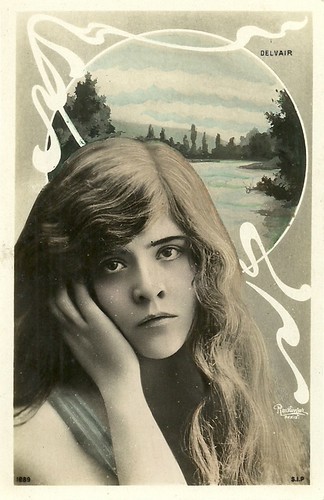
French postcard by S.I.P. no. 1239. Photo: Reutlinger, Paris.
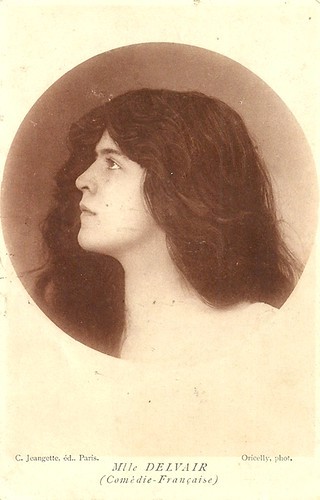
French postcard by Ed. C. Jeangette, Paris for the Comédie Française. Photo: Oricelly.
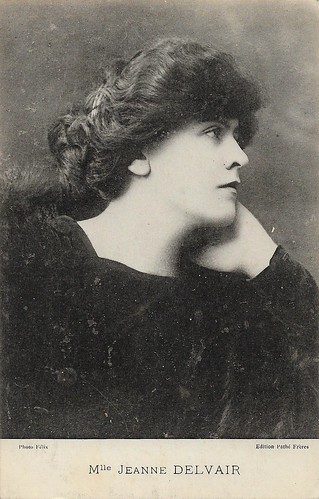
French postcard by Edition Pathé Frères. Photo: Félix.
Mingling historical and modern dramas
Jeanne Delvair was born Jeanne Louise Deluermoz in 1877 in Paris, as the daughter of a former gendarme of the Imperial Guard who became a wine merchant.
She entered the Conservatoire where she won the first comedy prize in 1898. In 1899 she entered the Comédie-Françoise, where most of her stage career revolved and where she was Sociétaire between 1910 and 1937.
In 1908 she debuted on film in the title role of the Film d'Art short Marie Stuart/Mary Stuart (Albert Capellani, 1908), also with Henry Krauss , Paul Cappellani and Véra Sergine . The film, focusing on the highlights in the life of Mary Queen of Scots, was well received internationally for its staging, acting and coloring.
Ciné-Ressources suggests she also had a minor part in L'Arlésienne in 1908 but the Seydoux Pathé site does not confirm this. Delvair then played Lady Macbeth in the William Shakespeare adaptation Macbeth (André Calmettes, 1909), with Paul Mounet in the title role.
IMDb claims Delvair had the title role in Capellani's Françoise de Rimini (Albert Capellani, 1910), adapted from Gabriele D'Annunzio, but Ciné-Ressources and Seydoux Pathé indicate this was a film by Film d'Arte Italiana with Francesca Bertini .
Next, Delvair had the title role opposite Edouard De Max in the Jean Racine adaptation Athalie (Michel Carré, Albert Capellani, 1910). Ciné-Ressources also mentions for 1910 the SCAGL film Un clair de lune sous Richelieu/A moonlight under Richelieu (Albert Capellani, 1910), scripted by Abel Gance , but the Pathe website lacks this film in its filmography. Likewise, Ciné-Ressources mentions the film Hernani as being with Delvair, but this was a Film d'Arte Italiana film with Bertini.
From 1910, Jeanne Delvair started to mingle historical dramas with modern dramas as Le Cœur pardonne/L’Amour qui aime (Georges Monca, 1910) opposite Georges Grand, Deux petits Jésus/Les Deux Jésus (Georges Denola, 1910), and Paillasse (Camille de Morlhon, 1910) with Louis Ravet in the title role. In the latter film, art and life mix when an enraged, deceived Paillasse avenges on his unfaithful wife on stage. Slowly, the spectators realise the staged death is a real one.
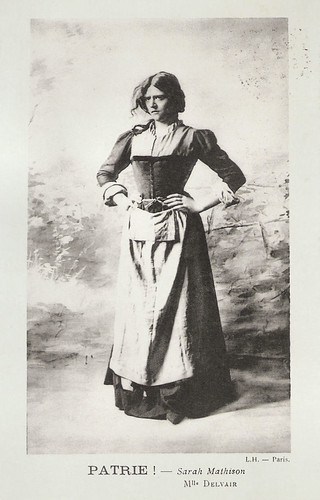
French postcard by L.H., Paris. Jeanne Delvair as Sarah Mathison in the play 'Patrie!' by Victorien Sardou, first performed in Paris in 1901 at the Comédie-Française.
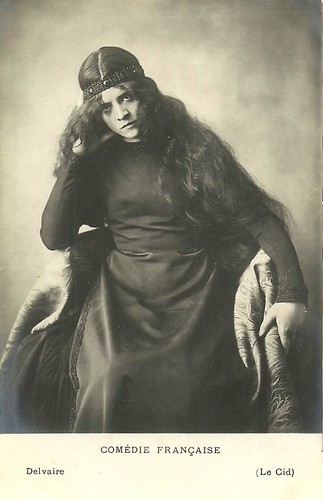
French postcard for the Comédie Française, C. 1900. Jeanne Delvair as Leonor in the classic tragicomedy 'Le Cid' (1636) by Corneille. Delvair's name is misspelled as Delvaire.
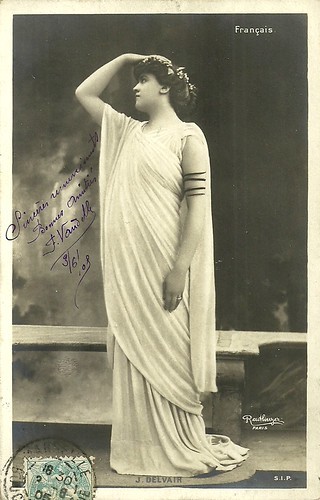
French postcard by SIP, no. not legible. Photo: Reutlinger, Paris. Handwritten date: 3/6/1908.
The Mysteries of Paris
Jeanne Delvair was Baucis opposite Romuald Joubé as Philémon in the Greek mythological tale (updated by La Fontaine) Philémon et Baucis (Georges Denola, 1911). In Les Mains vengeresses (Georges Monca, 1911) a vagabond kills his lookalike and takes his place in a friendly home. The murdered man's wife (Delvair) more and more suspects her supposed man, and when she discovers that he killed her husband, she strangles him with her own hands (hence the film's title). Georges Grand played both men. After that it was time for another adaptation of a classic play, this time Pierre Corneille's Polyeucte (Camille De Morlhon, 1911).
In 1912 Delvair played Miss Sarah MacGrégor in the Eugène Sue adaptation Les Mystères de Paris/Mysteries of Paris (Albert Capellani, 1912), produced by SCAGL. Delvair was part of an all-star cast. Grand duke Rodolphe ( Paul Capellani ) secretly has a child with Lady Sarah (Delvair). When his father tries to break up their union, Sarah suggests a patricide. When this is revealed, she flees to the US and leaves her child with a farmer's wife near Paris. When Rodolphe searches for his child, the house she is in is burned to the ground. Rodolphe swears revenge against the criminals. He meets the evil Schoolmaster (Henri Etiévant) and his accomplice La Chouette (Eugénie Nau) and discovers his daughter is not dead but works as a beggar for them under the name of Fleur-de-Marie (Andrée Pascal). After many dangers, Rodolphe finds his daughter back and pardons Sarah. Les Mystères de Paris was often filmed, in 1922 (see our blogpost), 1935, 1943, 1957, and 1962.
In 1912, Jeanne Delvair also played Jocaste in the Eclipse production Oedipe-roi (Gaston Roudès, 1912) with Jean Hervé as the young Oedipus, Mounet-Sully as king Oedipus and his father, and Paul Mounet as Tiresias. That year, she also played in the François Coppée adaptation Pour la couronne, directed by Henri Pouctal for Film d'Art. Pouctal also directed Delvair in the Eugène Brieux adaptation La Robe rouge (Henri Pouctal, 1912), again for Film d'Art.
IMDb attributes Pathé's Anna Karénine/Anna Karenina also to Delvair and Paul Capellani , but this was a Russian production with Russian actors, made for Pathé's Moscow studio. In 1913 Delvair worked for the company Cosmograph in the film, playing Queen Elisabeth in Les Enfants d'Edouard/Edward's Children (Henri Andréani, 1913), and Miss Ketty in Jacques l'Honneur (Henri Andréani, 1913). At Pathé, she had he lead in Le Baiser suprême (Edmond Floury, 1913). In 1914 she acted in the title role of Marie Tudor/Mary Tudor (Albert Capellani, 1914), but the film was only released in 1917. Again Delvair was surrounded by famous faces: Paul Capellani , Romuald Joubé , Léon Bernard , and Andrée Pascal .
After years of absence from the sets during WWI, Delvair returned in 1917 for the modern crime drama Blessée au coeur/Wounded in the heart , for whom the director is unknown. Jean Ayme, René Rocher and Georges Tréville were her co-actors, but the press focused on her presence. After another gap, she returned in 1920 with La Double existence du docteur Morart/The Double Life of Doctor Morart by Jacques Grétillat, with the director in the male lead as a surgeon whose wife (Delvair) suspects him of infidelity, but whose son (Jean Debucourt) discovers instead he is an alcoholic.
Delvair's last parts were in the Émile Zola adaptation Le Rêve/The Dream (Jacques de Baroncelli, 1921) with Gabriel Signoret , and in Le loup-garou/The Werewolf (Jacques Roullet, Pierre Bressol, 1923). Delvair stopped film acting after that, but continued her stage career.
Jeanne Delvair died in Levallois-Perret in 1949. She was 71. Delvair was buried with her husband Georges Le Roy (1885-1965), who was also a member of the Comédie-Française, in the cemetery of Marly-le-Roi (Yvelines).
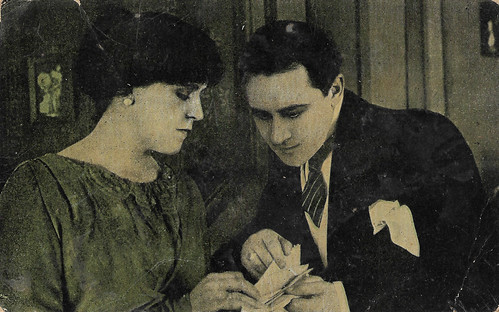
Spanish postcard for Chocolate Pi, Barcelona, by Ed. Auber y Pla, Barcelona, no. 2 (of 6 cards). Photo: Pathé Frères / Vilaseca y Ledesma. Jeanne Delvair and René Rocher in Blessée au coeur (N.N., 1917). The Spanish release title of the film was Herida del corazon.
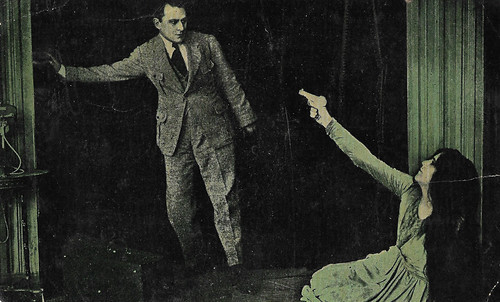
Spanish postcard for Chocolate Pi, Barcelona, by Ed. Auber y Pla, Barcelona, no. 3 (of 6 cards). Photo: Pathé Frères / Vilaseca y Ledesma. Jeanne Delvair and Jeam Ayme in Blessée au coeur (N.N., 1917). The Spanish release title of the film was Herida del corazon.
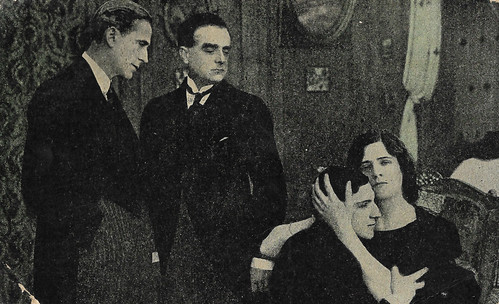
Spanish postcard for Chocolate Pi, Barcelona, by Ed. Auber y Pla, Barcelona, no. 6 (of 6 cards). Photo: Pathé Frères / Vilaseca y Ledesma. Georges Tréville, René Rocher and Jeanne Delvair in Blessée au coeur (N.N., 1917). The Spanish release title of the film was Herida del corazon.
Sources: Fondation Seydoux Pathé (French), Ciné-Ressources (French), Gallica (French), Wikipedia (French) and .

French postcard by S.I.P. no. 1239. Photo: Reutlinger, Paris.

French postcard by Ed. C. Jeangette, Paris for the Comédie Française. Photo: Oricelly.

French postcard by Edition Pathé Frères. Photo: Félix.
Mingling historical and modern dramas
Jeanne Delvair was born Jeanne Louise Deluermoz in 1877 in Paris, as the daughter of a former gendarme of the Imperial Guard who became a wine merchant.
She entered the Conservatoire where she won the first comedy prize in 1898. In 1899 she entered the Comédie-Françoise, where most of her stage career revolved and where she was Sociétaire between 1910 and 1937.
In 1908 she debuted on film in the title role of the Film d'Art short Marie Stuart/Mary Stuart (Albert Capellani, 1908), also with Henry Krauss , Paul Cappellani and Véra Sergine . The film, focusing on the highlights in the life of Mary Queen of Scots, was well received internationally for its staging, acting and coloring.
Ciné-Ressources suggests she also had a minor part in L'Arlésienne in 1908 but the Seydoux Pathé site does not confirm this. Delvair then played Lady Macbeth in the William Shakespeare adaptation Macbeth (André Calmettes, 1909), with Paul Mounet in the title role.
IMDb claims Delvair had the title role in Capellani's Françoise de Rimini (Albert Capellani, 1910), adapted from Gabriele D'Annunzio, but Ciné-Ressources and Seydoux Pathé indicate this was a film by Film d'Arte Italiana with Francesca Bertini .
Next, Delvair had the title role opposite Edouard De Max in the Jean Racine adaptation Athalie (Michel Carré, Albert Capellani, 1910). Ciné-Ressources also mentions for 1910 the SCAGL film Un clair de lune sous Richelieu/A moonlight under Richelieu (Albert Capellani, 1910), scripted by Abel Gance , but the Pathe website lacks this film in its filmography. Likewise, Ciné-Ressources mentions the film Hernani as being with Delvair, but this was a Film d'Arte Italiana film with Bertini.
From 1910, Jeanne Delvair started to mingle historical dramas with modern dramas as Le Cœur pardonne/L’Amour qui aime (Georges Monca, 1910) opposite Georges Grand, Deux petits Jésus/Les Deux Jésus (Georges Denola, 1910), and Paillasse (Camille de Morlhon, 1910) with Louis Ravet in the title role. In the latter film, art and life mix when an enraged, deceived Paillasse avenges on his unfaithful wife on stage. Slowly, the spectators realise the staged death is a real one.

French postcard by L.H., Paris. Jeanne Delvair as Sarah Mathison in the play 'Patrie!' by Victorien Sardou, first performed in Paris in 1901 at the Comédie-Française.

French postcard for the Comédie Française, C. 1900. Jeanne Delvair as Leonor in the classic tragicomedy 'Le Cid' (1636) by Corneille. Delvair's name is misspelled as Delvaire.

French postcard by SIP, no. not legible. Photo: Reutlinger, Paris. Handwritten date: 3/6/1908.
The Mysteries of Paris
Jeanne Delvair was Baucis opposite Romuald Joubé as Philémon in the Greek mythological tale (updated by La Fontaine) Philémon et Baucis (Georges Denola, 1911). In Les Mains vengeresses (Georges Monca, 1911) a vagabond kills his lookalike and takes his place in a friendly home. The murdered man's wife (Delvair) more and more suspects her supposed man, and when she discovers that he killed her husband, she strangles him with her own hands (hence the film's title). Georges Grand played both men. After that it was time for another adaptation of a classic play, this time Pierre Corneille's Polyeucte (Camille De Morlhon, 1911).
In 1912 Delvair played Miss Sarah MacGrégor in the Eugène Sue adaptation Les Mystères de Paris/Mysteries of Paris (Albert Capellani, 1912), produced by SCAGL. Delvair was part of an all-star cast. Grand duke Rodolphe ( Paul Capellani ) secretly has a child with Lady Sarah (Delvair). When his father tries to break up their union, Sarah suggests a patricide. When this is revealed, she flees to the US and leaves her child with a farmer's wife near Paris. When Rodolphe searches for his child, the house she is in is burned to the ground. Rodolphe swears revenge against the criminals. He meets the evil Schoolmaster (Henri Etiévant) and his accomplice La Chouette (Eugénie Nau) and discovers his daughter is not dead but works as a beggar for them under the name of Fleur-de-Marie (Andrée Pascal). After many dangers, Rodolphe finds his daughter back and pardons Sarah. Les Mystères de Paris was often filmed, in 1922 (see our blogpost), 1935, 1943, 1957, and 1962.
In 1912, Jeanne Delvair also played Jocaste in the Eclipse production Oedipe-roi (Gaston Roudès, 1912) with Jean Hervé as the young Oedipus, Mounet-Sully as king Oedipus and his father, and Paul Mounet as Tiresias. That year, she also played in the François Coppée adaptation Pour la couronne, directed by Henri Pouctal for Film d'Art. Pouctal also directed Delvair in the Eugène Brieux adaptation La Robe rouge (Henri Pouctal, 1912), again for Film d'Art.
IMDb attributes Pathé's Anna Karénine/Anna Karenina also to Delvair and Paul Capellani , but this was a Russian production with Russian actors, made for Pathé's Moscow studio. In 1913 Delvair worked for the company Cosmograph in the film, playing Queen Elisabeth in Les Enfants d'Edouard/Edward's Children (Henri Andréani, 1913), and Miss Ketty in Jacques l'Honneur (Henri Andréani, 1913). At Pathé, she had he lead in Le Baiser suprême (Edmond Floury, 1913). In 1914 she acted in the title role of Marie Tudor/Mary Tudor (Albert Capellani, 1914), but the film was only released in 1917. Again Delvair was surrounded by famous faces: Paul Capellani , Romuald Joubé , Léon Bernard , and Andrée Pascal .
After years of absence from the sets during WWI, Delvair returned in 1917 for the modern crime drama Blessée au coeur/Wounded in the heart , for whom the director is unknown. Jean Ayme, René Rocher and Georges Tréville were her co-actors, but the press focused on her presence. After another gap, she returned in 1920 with La Double existence du docteur Morart/The Double Life of Doctor Morart by Jacques Grétillat, with the director in the male lead as a surgeon whose wife (Delvair) suspects him of infidelity, but whose son (Jean Debucourt) discovers instead he is an alcoholic.
Delvair's last parts were in the Émile Zola adaptation Le Rêve/The Dream (Jacques de Baroncelli, 1921) with Gabriel Signoret , and in Le loup-garou/The Werewolf (Jacques Roullet, Pierre Bressol, 1923). Delvair stopped film acting after that, but continued her stage career.
Jeanne Delvair died in Levallois-Perret in 1949. She was 71. Delvair was buried with her husband Georges Le Roy (1885-1965), who was also a member of the Comédie-Française, in the cemetery of Marly-le-Roi (Yvelines).

Spanish postcard for Chocolate Pi, Barcelona, by Ed. Auber y Pla, Barcelona, no. 2 (of 6 cards). Photo: Pathé Frères / Vilaseca y Ledesma. Jeanne Delvair and René Rocher in Blessée au coeur (N.N., 1917). The Spanish release title of the film was Herida del corazon.

Spanish postcard for Chocolate Pi, Barcelona, by Ed. Auber y Pla, Barcelona, no. 3 (of 6 cards). Photo: Pathé Frères / Vilaseca y Ledesma. Jeanne Delvair and Jeam Ayme in Blessée au coeur (N.N., 1917). The Spanish release title of the film was Herida del corazon.

Spanish postcard for Chocolate Pi, Barcelona, by Ed. Auber y Pla, Barcelona, no. 6 (of 6 cards). Photo: Pathé Frères / Vilaseca y Ledesma. Georges Tréville, René Rocher and Jeanne Delvair in Blessée au coeur (N.N., 1917). The Spanish release title of the film was Herida del corazon.
Sources: Fondation Seydoux Pathé (French), Ciné-Ressources (French), Gallica (French), Wikipedia (French) and .
Published on August 04, 2020 22:00
August 3, 2020
Liebe und Diebe (1928)
We continue our series of Henny Porten film specials with postcards by Ross Verlag. Today, the silent comedy Liebe und Diebe/Love and Thieves (Carl Froehlich, 1928) in which she once again played a double role. Her co-star was Anton Pointner.
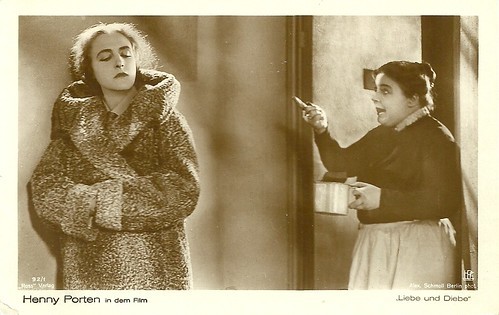
German postcard by Ross Verlag, no. 92/1. Photo: Alex Schmoll, Berlin / Henny Porten-Froehlich Produktion. Henny Porten in Liebe und Diebe (Carl Froehlich, 1928).
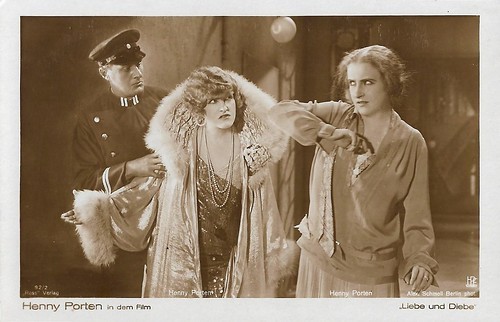
German postcard by Ross Verlag, no. 92/2. Photo: Alex Schmoll, Berlin / Henny Porten-Froehlich Produktion. Henny Porten in a double role in Liebe und Diebe (Carl Froehlich, 1928).
A thief called Brillanten-Anna
In Liebe und Diebe/Love and Thieves (Carl Froehlich, 1928), Henny Porten plays Baroness Anna von Belling, who is staying in a posh Wiesbaden hotel, when her jewelry, valuable diamonds, are stolen.
The Baroness personally pursues the thief but is promptly mistaken for an impostor whom the police have long sought. Taken into custody, Ms. von Belling is only released when her own uncle confirms her identity.
The hotel guest who, in their eyes, has made himself particularly suspicious, turns out to be a detective and her stolen jewelry proves to be fake. As if by coincidence, the real thief Anna Magdalena Kaludrigkeit, internally called 'Brillanten-Anna' (also Porten), appears.
'Brillanten-Anna' has just returned from a thief tour and has a striking resemblance to her noble namesake. After all the confusion, Baroness Anna and the police commissioner von Langen (Anton Pointner), who handled the case, get closer and get married.
Other actors in the film were Kurt Gerron, Paul Bildt, Adolphe Engers , Karl Geppert, Oreste Bilancia , Hubert von Meyerinck, and Ellen Kürti. Liebe und Diebe was scripted by Walter Wassermann and Fred Sauer, and cinematographed by Gustav Preiss. Sets were designed by Franz Schroedter, while Porten's husband Wilhelm von Kaufmann was the production manager. The film was shot in November-December 1927 and premiered on 8 March 1928 at the famous Ufa-Palast am Zoo.
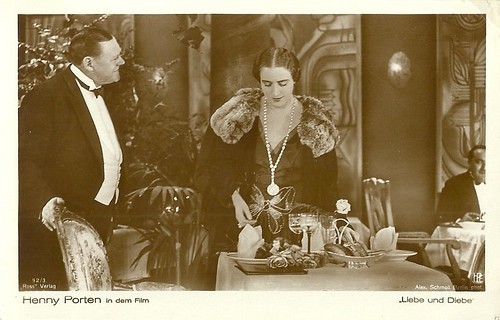
German postcard by Ross Verlag, no. 92/3. Photo: Alex Schmoll, Berlin / Henny Porten-Froehlich Produktion. Henny Porten in Liebe und Diebe (Carl Froehlich, 1928).
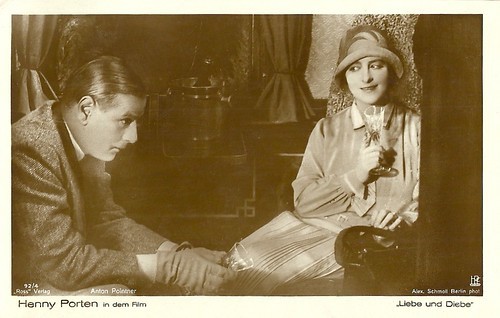
German postcard by Ross Verlag, no. 92/4. Photo: Alex Schmoll, Berlin / Henny Porten-Froehlich Produktion. Anton Pointner and Henny Porten in Liebe und Diebe (Carl Froehlich, 1928).
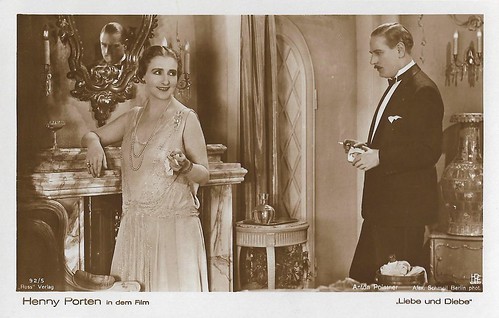
German postcard by Ross Verlag, no. 92/5. Photo: Alex Schmoll, Berlin / Henny Porten-Froehlich Produktion. Henny Porten and Anton Pointner in Liebe und Diebe (Carl Froehlich, 1928).
Sources: Wikipedia (German and English), and IMDb.

German postcard by Ross Verlag, no. 92/1. Photo: Alex Schmoll, Berlin / Henny Porten-Froehlich Produktion. Henny Porten in Liebe und Diebe (Carl Froehlich, 1928).

German postcard by Ross Verlag, no. 92/2. Photo: Alex Schmoll, Berlin / Henny Porten-Froehlich Produktion. Henny Porten in a double role in Liebe und Diebe (Carl Froehlich, 1928).
A thief called Brillanten-Anna
In Liebe und Diebe/Love and Thieves (Carl Froehlich, 1928), Henny Porten plays Baroness Anna von Belling, who is staying in a posh Wiesbaden hotel, when her jewelry, valuable diamonds, are stolen.
The Baroness personally pursues the thief but is promptly mistaken for an impostor whom the police have long sought. Taken into custody, Ms. von Belling is only released when her own uncle confirms her identity.
The hotel guest who, in their eyes, has made himself particularly suspicious, turns out to be a detective and her stolen jewelry proves to be fake. As if by coincidence, the real thief Anna Magdalena Kaludrigkeit, internally called 'Brillanten-Anna' (also Porten), appears.
'Brillanten-Anna' has just returned from a thief tour and has a striking resemblance to her noble namesake. After all the confusion, Baroness Anna and the police commissioner von Langen (Anton Pointner), who handled the case, get closer and get married.
Other actors in the film were Kurt Gerron, Paul Bildt, Adolphe Engers , Karl Geppert, Oreste Bilancia , Hubert von Meyerinck, and Ellen Kürti. Liebe und Diebe was scripted by Walter Wassermann and Fred Sauer, and cinematographed by Gustav Preiss. Sets were designed by Franz Schroedter, while Porten's husband Wilhelm von Kaufmann was the production manager. The film was shot in November-December 1927 and premiered on 8 March 1928 at the famous Ufa-Palast am Zoo.

German postcard by Ross Verlag, no. 92/3. Photo: Alex Schmoll, Berlin / Henny Porten-Froehlich Produktion. Henny Porten in Liebe und Diebe (Carl Froehlich, 1928).

German postcard by Ross Verlag, no. 92/4. Photo: Alex Schmoll, Berlin / Henny Porten-Froehlich Produktion. Anton Pointner and Henny Porten in Liebe und Diebe (Carl Froehlich, 1928).

German postcard by Ross Verlag, no. 92/5. Photo: Alex Schmoll, Berlin / Henny Porten-Froehlich Produktion. Henny Porten and Anton Pointner in Liebe und Diebe (Carl Froehlich, 1928).
Sources: Wikipedia (German and English), and IMDb.
Published on August 03, 2020 22:00
August 2, 2020
Maria Melato
Italian actress Maria Melato (1885-1950) appeared in the theatre, on radio, and in the cinema. Her films included Ritorno/Return (1914), Anna Karenina (1917), and Il volo degli aironi/The flight of the herons (1920). Unfortunately, all her films are considered lost.
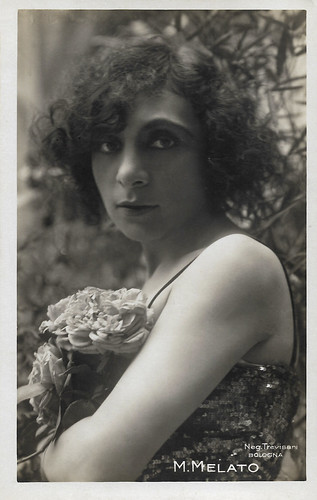
Italian postcard by Vettori, Bologna. Photo: Trevisani, Bologna.
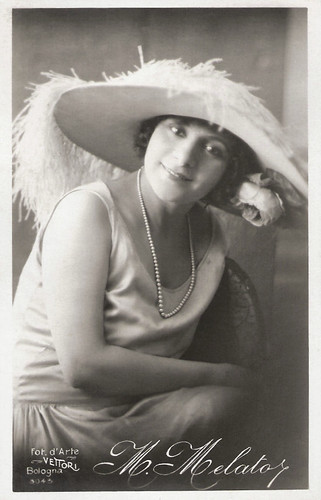
Italian postcard by Foto d'Arte Vettori Bologna, no. 3043.
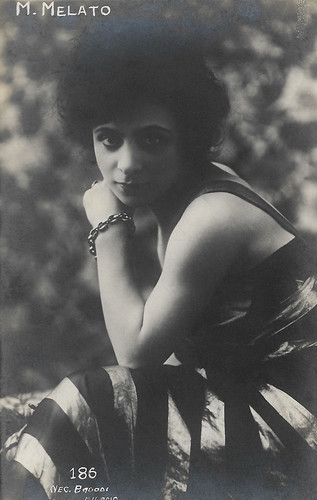
Italian postcard by Neg. Badodi, Milano, no. 186.
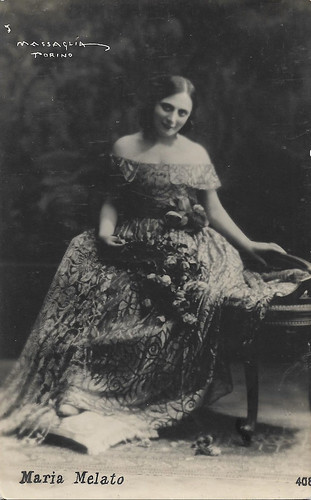
Italian postcard, no. 408. Photo: Massaglia, Torino.
Maturing under the severe and passionate leadership of Virgilio Talli
Maria Melato was born in 1885 in Reggio Emilia, as the daughter of the fencing instructor Silvio Melato and the noble lady Elisa Friggieri. Already in childhood Melato manifested a penchant for acting.
She began her very rich artistic career first at the Berti-Masi company in 1903, then served as a love interest in the company of Teresa Mariani and Vittorio Zampieri. Later she became the first young actress (prima attrice giovane) in the company of Irma Gramatica and Flavio Andò.
But her real maturation occurred under the severe and passionate leadership of Virgilio Talli, the greatest artistic director of his time. It was with him that from 1909 to 1921 Melato composed a famous triad with Annibale Betrone and Alberto Giovannini: until 1918 with a classical repertoire, afterward experiencing with more current texts that treated modern issues such as those by Luigi Pirandello, e.g. 'Così è (se vi pare)', and other authors such as Rosso di San Secondo, Bontempelli, and Gabriele D'Annunzio.
Melato also tried her hand in film acting in a few films. Her debut was Ritorno (Luca Comerio, 1914) with D’Annunzio’s son Gabriellino co-starring. It was followed by a series of films directed by Ugo Falena: Anna Karenina (Ugo Falena, 1917) with Fabienne Fabrèges, Le due Marie (Mario Corsi, Ugo Falena, 1918), Il volo degli aironi (Ugo Falena, 1920) with Ileana Leonidoff , Il trittico d’amore (Ugo Falena, 1920) with Mimi Aylmer and Eduardo Scarpetta, and Le due esistenze (Ugo Falena, Giorgio Ricci). Unfortunately, all are lost.
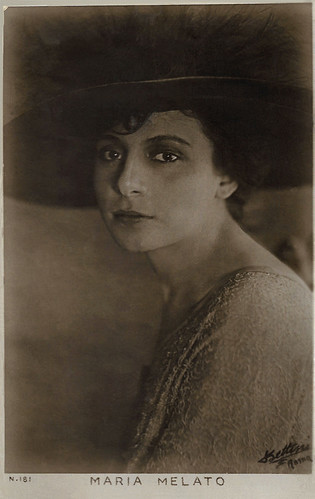
Italian postcard by Ed. Soc. Anon. It. Bettini, Roma, no. 181.
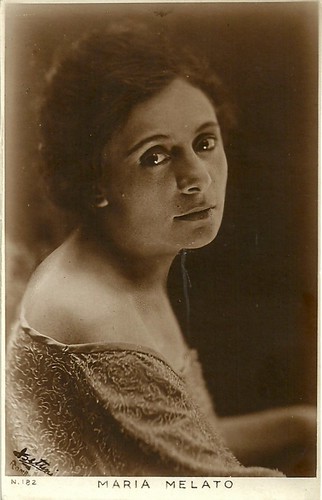
Italian postcard by Photo Ed. Soc. Anon. It. Bettini, Roma, no. 182.
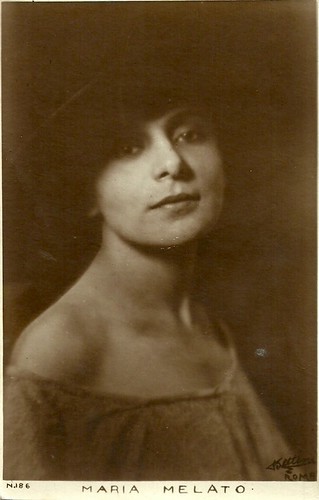
Italian postcard by Photo Ed. Soc. Anon. It. Bettini, Roma, no. 186.
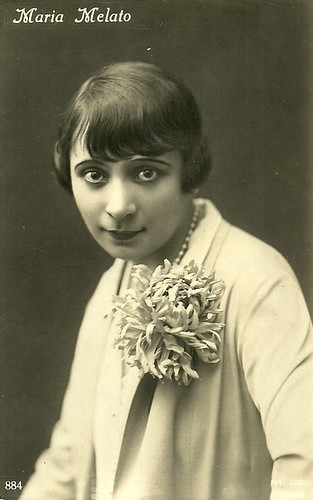
Italian postcard by Ed. A. Traldi, Milano, no. 884. Photo: Badodi.
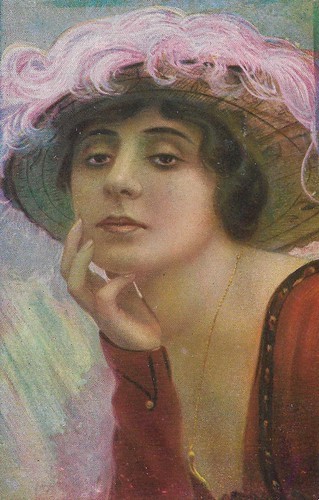
Italian postcard by CENV in the Le Dive series, no. 5.
Malicious accusations of 'singing'
In 1921 a turning point happened: Maria Melato left Virgilio Talli’s company and became 'capocomica' (head actor) with Annibale Betrone . Her greatest period of artistic fervor started, in which she was busy with every aspect of 'doing theatre': the direction or adaptation of texts, the formation of actors, as well as designing costumes.
From 1922 onward, she formed various theatre companies. In 1923 and 1925 she brought her stage performances to Latin America with great success. In 1927 she triumphed at the Vittoriale with her interpretation in 'La figlia di Jorio' (Jorio's Daughter) by Gabriele D'Annunzio.
In the 1930s, Melato had to return to more traditional themes and authors, satisfying the guidelines of the moment and forming her own company again with Betrone and with direction by Luigi Carini. Compared by her admirers to Eleanore Duse for their same emotional tension and heightened sensitivity. Se possessed a vocal range that led her to excessive phonic complacency, leading to malicious accusations of 'singing'.
In the three years 1937-1940 she was the star of Oscar Wilde's 'The Duchess of Padua' and 'Tosca' by Victorien Sardou, opposite Piero Carnabuci and Gino Sabbatini, while in the postwar years she revisited D'Annunzio, Mario Praga, Dario Niccodemi, Jean Cocteau and others. In particular in 1938, when she was associated with the Company Ninchi-Abba-Pilotto.
During the war years, she played some minor parts in Italian sound films, such as La principessa del sogno (Maria Teresa Ricci, Roberto Savarese, 1942) with Annibale Betrone , Irasema Dilian, and Antonio Centa . She acted opposite Adriana Benetti and Massimo Serato in Quartieri alti (Mario Soldati, 1945), about a young man kept by a rich and old aristocratic lady, who has two actors posing as his parents, to impress his beloved.
Following the vicissitudes of the war, the actress, now in her sixties, began to lose ground. Left for her were just some second category performances and radio work. So she left the stage in 1948 with 'Casa paterna' (Heimat/Homeland) by Hermann Sudermann, before retiring to Versilia.
Maria Melato died in 1950 in Lucca after a bad fall from her train while trying to reach Turin for the radio programme 'La sacra fiamma' (The sacred flame) by W. Somerset Maugham. She was 64. She lies buried next to stage and screen actor Romolo Valli in the monumental cemetery of Reggio Emilia. Maria Melato had a son, Luciano, born in 1909.
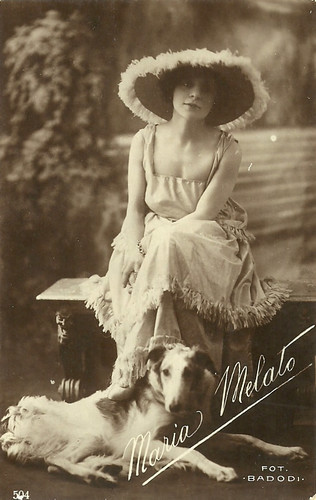
Italian postcard by Ed. A. Traldi, Milano, no. 504. Photo: Badodi, Milano.
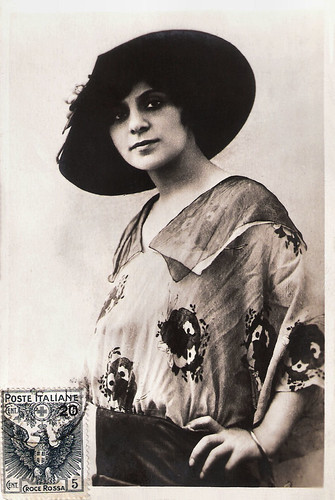
Italian postcard by A.G.F. Sent by mail in 1919.
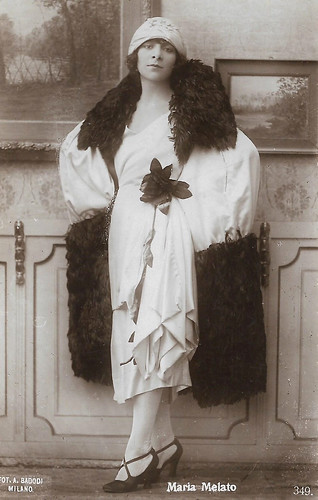
Italian postcard by Ed. A. Traldi, Milano, no. 349. Photo: A. Badodi, Milano.
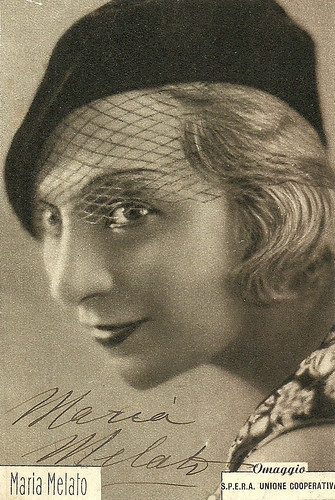
Italian collectors card by S.P.E.R.A. Unione Cooperativa.
Sources: Wikipedia (Italian and English), and .

Italian postcard by Vettori, Bologna. Photo: Trevisani, Bologna.

Italian postcard by Foto d'Arte Vettori Bologna, no. 3043.

Italian postcard by Neg. Badodi, Milano, no. 186.

Italian postcard, no. 408. Photo: Massaglia, Torino.
Maturing under the severe and passionate leadership of Virgilio Talli
Maria Melato was born in 1885 in Reggio Emilia, as the daughter of the fencing instructor Silvio Melato and the noble lady Elisa Friggieri. Already in childhood Melato manifested a penchant for acting.
She began her very rich artistic career first at the Berti-Masi company in 1903, then served as a love interest in the company of Teresa Mariani and Vittorio Zampieri. Later she became the first young actress (prima attrice giovane) in the company of Irma Gramatica and Flavio Andò.
But her real maturation occurred under the severe and passionate leadership of Virgilio Talli, the greatest artistic director of his time. It was with him that from 1909 to 1921 Melato composed a famous triad with Annibale Betrone and Alberto Giovannini: until 1918 with a classical repertoire, afterward experiencing with more current texts that treated modern issues such as those by Luigi Pirandello, e.g. 'Così è (se vi pare)', and other authors such as Rosso di San Secondo, Bontempelli, and Gabriele D'Annunzio.
Melato also tried her hand in film acting in a few films. Her debut was Ritorno (Luca Comerio, 1914) with D’Annunzio’s son Gabriellino co-starring. It was followed by a series of films directed by Ugo Falena: Anna Karenina (Ugo Falena, 1917) with Fabienne Fabrèges, Le due Marie (Mario Corsi, Ugo Falena, 1918), Il volo degli aironi (Ugo Falena, 1920) with Ileana Leonidoff , Il trittico d’amore (Ugo Falena, 1920) with Mimi Aylmer and Eduardo Scarpetta, and Le due esistenze (Ugo Falena, Giorgio Ricci). Unfortunately, all are lost.

Italian postcard by Ed. Soc. Anon. It. Bettini, Roma, no. 181.

Italian postcard by Photo Ed. Soc. Anon. It. Bettini, Roma, no. 182.

Italian postcard by Photo Ed. Soc. Anon. It. Bettini, Roma, no. 186.

Italian postcard by Ed. A. Traldi, Milano, no. 884. Photo: Badodi.

Italian postcard by CENV in the Le Dive series, no. 5.
Malicious accusations of 'singing'
In 1921 a turning point happened: Maria Melato left Virgilio Talli’s company and became 'capocomica' (head actor) with Annibale Betrone . Her greatest period of artistic fervor started, in which she was busy with every aspect of 'doing theatre': the direction or adaptation of texts, the formation of actors, as well as designing costumes.
From 1922 onward, she formed various theatre companies. In 1923 and 1925 she brought her stage performances to Latin America with great success. In 1927 she triumphed at the Vittoriale with her interpretation in 'La figlia di Jorio' (Jorio's Daughter) by Gabriele D'Annunzio.
In the 1930s, Melato had to return to more traditional themes and authors, satisfying the guidelines of the moment and forming her own company again with Betrone and with direction by Luigi Carini. Compared by her admirers to Eleanore Duse for their same emotional tension and heightened sensitivity. Se possessed a vocal range that led her to excessive phonic complacency, leading to malicious accusations of 'singing'.
In the three years 1937-1940 she was the star of Oscar Wilde's 'The Duchess of Padua' and 'Tosca' by Victorien Sardou, opposite Piero Carnabuci and Gino Sabbatini, while in the postwar years she revisited D'Annunzio, Mario Praga, Dario Niccodemi, Jean Cocteau and others. In particular in 1938, when she was associated with the Company Ninchi-Abba-Pilotto.
During the war years, she played some minor parts in Italian sound films, such as La principessa del sogno (Maria Teresa Ricci, Roberto Savarese, 1942) with Annibale Betrone , Irasema Dilian, and Antonio Centa . She acted opposite Adriana Benetti and Massimo Serato in Quartieri alti (Mario Soldati, 1945), about a young man kept by a rich and old aristocratic lady, who has two actors posing as his parents, to impress his beloved.
Following the vicissitudes of the war, the actress, now in her sixties, began to lose ground. Left for her were just some second category performances and radio work. So she left the stage in 1948 with 'Casa paterna' (Heimat/Homeland) by Hermann Sudermann, before retiring to Versilia.
Maria Melato died in 1950 in Lucca after a bad fall from her train while trying to reach Turin for the radio programme 'La sacra fiamma' (The sacred flame) by W. Somerset Maugham. She was 64. She lies buried next to stage and screen actor Romolo Valli in the monumental cemetery of Reggio Emilia. Maria Melato had a son, Luciano, born in 1909.

Italian postcard by Ed. A. Traldi, Milano, no. 504. Photo: Badodi, Milano.

Italian postcard by A.G.F. Sent by mail in 1919.

Italian postcard by Ed. A. Traldi, Milano, no. 349. Photo: A. Badodi, Milano.

Italian collectors card by S.P.E.R.A. Unione Cooperativa.
Sources: Wikipedia (Italian and English), and .
Published on August 02, 2020 22:00
August 1, 2020
Anne Crawford
Anne Crawford (1920-1956) was a beautiful, sadly short-lived British leading lady with a gentle, good-humoured personality. From 1938 through 1954 she starred in 24 films.
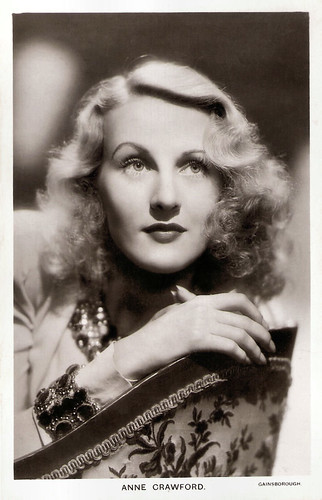
British postcard in the Picturegoer Series, London, no. W 153. Photo: Gainsborough.
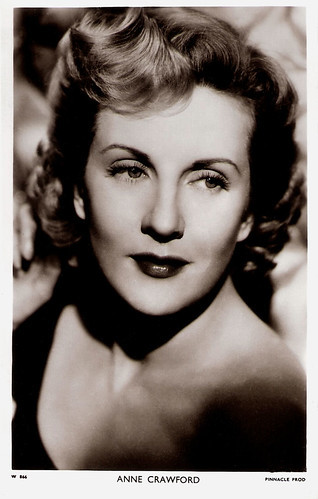
British postcard in the Picturegoer Series, London, no. W 866. Photo: Pinnacle Prod.
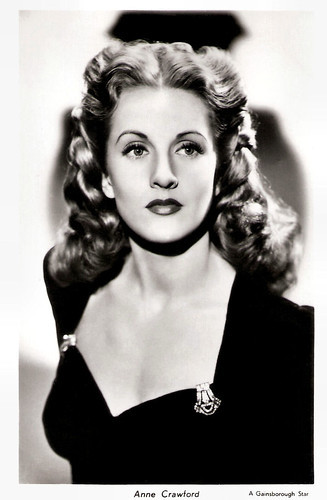
British postcard by Real Photographs Company Ltd, Southport. Photo: Gainsborough.
Posh, selfish but basically a good sort
Anne Crawford was born in 1920 in Haifa, Palestine (now Israel) as Imelda Anne Crawford. She was the child of an English mother and a Scottish father, who worked as a paymaster for the Palestine Railway.
The family returned to Britain when she was 7 years old. Raised in Edinburgh, she went to school at St. Margrets convent in Marchmont.
Afterward, she studied drama in Edinburgh and at the Royal Academy of Dramatic Arts (RADA) in London. Her professional career started at a repertory theatre in Manchester where she soon was playing juvenile leads.
She changed her name from Imelda to Anne. She had a tiny role in Prison Without Bars (Brian Desmond Hurst, 1938) with Corinne Luchaire and Edna Best , and a better role in They Flew Alone (Herbert Wilcox, 1942) starring Anna Neagle .
It was the smash hit Millions Like Us (Frank Launder, Sydney Gilliat, 1943) that crystalised her star persona: posh, selfish but basically a good sort. During her career, there were a few attempts to get away from this template, notably her poor mill worker in Master of Banksdam (Walter Forde, 1947) with Dennis Price .
During the war, she also appeared in such women's pictures as Two Thousand Women (Frank Launder, 1944) with Phyllis Calvert and Flora Robson , and They Were Sisters (Arthur Crabtree, 1945) with James Mason .
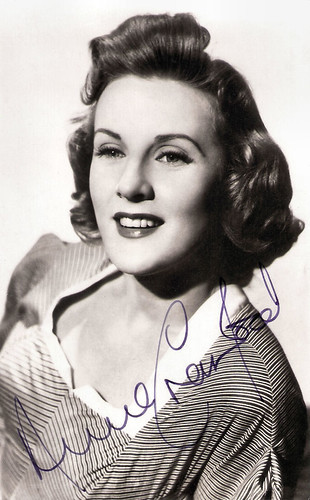
British autograph card.
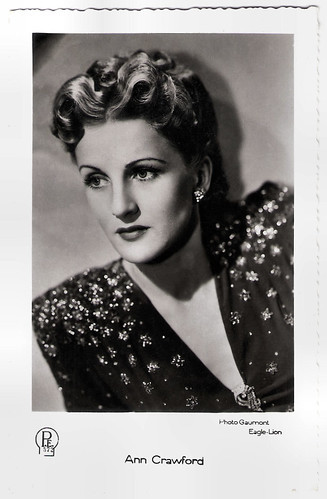
Belgian postcard by P.E. (Photo Edition, Brussels), no. 572. Photo: Gaumont / Eagle-Lion.
One of the most startling British films of the 1940s
After the war, Anne Crawford became known for the wild Gainsborough melodrama Caravan (Arthur Crabtree, 1946) starring Stewart Granger and Jean Kent , and the classic horror film Daughter of Darkness (Lance Comfort, 1948).
In his Guide to British Cinema, Geoff Mayer writes, "Daughter of Darkness, with a budget of two hundred thousand pounds and three weeks of location shooting in Cornwall, was not a financial success and represented a setback to Comfort's career, which saw him relegated to low-budget films in the 1950s and 1960s. Yet the film's mixture of gothic and horror establishes it as one of the most startling British films of the 1940s."
In 1953 she starred as Morgan Le Fay in Knights of the Round Table (Richard Thorpe, 1953), with Robert Taylor and Ava Gardner .
She made her West End debut in 1949 in 'Western Wind' at the Piccadilly Theatre, followed by a not very successful stint on Broadway in 1951 in 'The Green Bay Tree'.
Her television career ran in parallel to her film career, and in 1955 she topped a viewers poll for her performance in the BBC teleplay The Leader of the House (Douglas Allen, 1955).
Anne Crawford died in 1956 in London of leukemia. She was only 35. At the time of her death, she was appearing in the Agatha Christie play 'The Spider's Web', at the Savoy Theatre, London. Co-stars Margaret Lockwood , Patrick Barr, and Ronald Howard attended her funeral. Her resting place is the Kensal Green Cemetery.
Crawford was married to James Hartley (1939-?) and stage and television producer/director Wallace Douglas (1953-1956). David Absalom at British Pictures: "For modern audiences, Crawford's perceived poshness can seem a bit distancing, and it's hard to judge how her career would have panned out had she not died so early. I suspect she would have done okay. She showed enough wit and timing in her few comedy outings and there was always something of the grande dame about her to suggest that she would have only improved with age."
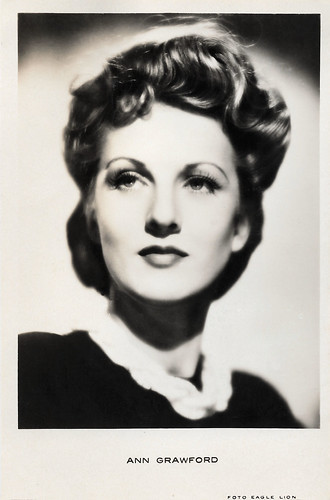
Dutch postcard by Hemo. Photo: Eagle Lion.
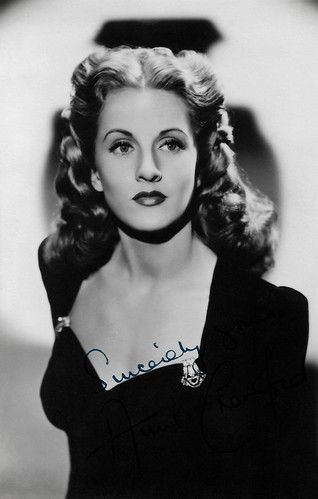
British autograph card. Photo: Gainsborough.
Sources: David Absalom (British Pictures), Fritz Tauber (Find A Grave), Find A Grave, Wikipedia, and .

British postcard in the Picturegoer Series, London, no. W 153. Photo: Gainsborough.

British postcard in the Picturegoer Series, London, no. W 866. Photo: Pinnacle Prod.

British postcard by Real Photographs Company Ltd, Southport. Photo: Gainsborough.
Posh, selfish but basically a good sort
Anne Crawford was born in 1920 in Haifa, Palestine (now Israel) as Imelda Anne Crawford. She was the child of an English mother and a Scottish father, who worked as a paymaster for the Palestine Railway.
The family returned to Britain when she was 7 years old. Raised in Edinburgh, she went to school at St. Margrets convent in Marchmont.
Afterward, she studied drama in Edinburgh and at the Royal Academy of Dramatic Arts (RADA) in London. Her professional career started at a repertory theatre in Manchester where she soon was playing juvenile leads.
She changed her name from Imelda to Anne. She had a tiny role in Prison Without Bars (Brian Desmond Hurst, 1938) with Corinne Luchaire and Edna Best , and a better role in They Flew Alone (Herbert Wilcox, 1942) starring Anna Neagle .
It was the smash hit Millions Like Us (Frank Launder, Sydney Gilliat, 1943) that crystalised her star persona: posh, selfish but basically a good sort. During her career, there were a few attempts to get away from this template, notably her poor mill worker in Master of Banksdam (Walter Forde, 1947) with Dennis Price .
During the war, she also appeared in such women's pictures as Two Thousand Women (Frank Launder, 1944) with Phyllis Calvert and Flora Robson , and They Were Sisters (Arthur Crabtree, 1945) with James Mason .

British autograph card.

Belgian postcard by P.E. (Photo Edition, Brussels), no. 572. Photo: Gaumont / Eagle-Lion.
One of the most startling British films of the 1940s
After the war, Anne Crawford became known for the wild Gainsborough melodrama Caravan (Arthur Crabtree, 1946) starring Stewart Granger and Jean Kent , and the classic horror film Daughter of Darkness (Lance Comfort, 1948).
In his Guide to British Cinema, Geoff Mayer writes, "Daughter of Darkness, with a budget of two hundred thousand pounds and three weeks of location shooting in Cornwall, was not a financial success and represented a setback to Comfort's career, which saw him relegated to low-budget films in the 1950s and 1960s. Yet the film's mixture of gothic and horror establishes it as one of the most startling British films of the 1940s."
In 1953 she starred as Morgan Le Fay in Knights of the Round Table (Richard Thorpe, 1953), with Robert Taylor and Ava Gardner .
She made her West End debut in 1949 in 'Western Wind' at the Piccadilly Theatre, followed by a not very successful stint on Broadway in 1951 in 'The Green Bay Tree'.
Her television career ran in parallel to her film career, and in 1955 she topped a viewers poll for her performance in the BBC teleplay The Leader of the House (Douglas Allen, 1955).
Anne Crawford died in 1956 in London of leukemia. She was only 35. At the time of her death, she was appearing in the Agatha Christie play 'The Spider's Web', at the Savoy Theatre, London. Co-stars Margaret Lockwood , Patrick Barr, and Ronald Howard attended her funeral. Her resting place is the Kensal Green Cemetery.
Crawford was married to James Hartley (1939-?) and stage and television producer/director Wallace Douglas (1953-1956). David Absalom at British Pictures: "For modern audiences, Crawford's perceived poshness can seem a bit distancing, and it's hard to judge how her career would have panned out had she not died so early. I suspect she would have done okay. She showed enough wit and timing in her few comedy outings and there was always something of the grande dame about her to suggest that she would have only improved with age."

Dutch postcard by Hemo. Photo: Eagle Lion.

British autograph card. Photo: Gainsborough.
Sources: David Absalom (British Pictures), Fritz Tauber (Find A Grave), Find A Grave, Wikipedia, and .
Published on August 01, 2020 22:00
July 31, 2020
Tiber Film
The Tiber Film company of Rome was founded in 1914 by producer Gioacchino Mecheri (1876-1942). Between 1915 and 1919, Tiber Film rivaled the other Roman company, Caesar Film, run by producer Giuseppe Barattolo. Both companies had a leading diva to profile itself with: Hesperia at Tiber Film, and Francesca Bertini at Caesar.
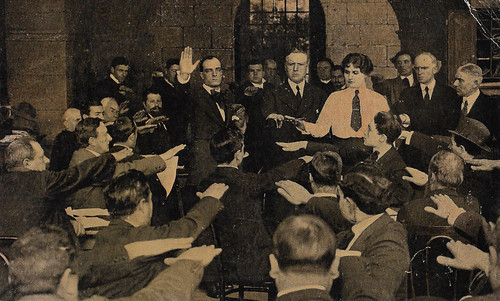
Spanish collectors card by Chocolate Pi, Barcelona, no. 2 of 6. Photo: Tiber Film. Hesperia and Emilio Ghione in Il potere sovrano (Baldassarre Negroni, Percy Nash, 1916).
Il potere sovrano was based on the novel 'Temporal Power' by Marie Corelli. Lotys ( Hesperia ) is the idol of the people. Therd ( Emilio Ghione ), a journalist, a man of action, and manager of the paper The Idea, is also beloved by his compatriots. Their ideals unite Lotys and Therd. The King ( Ignazio Lupi ) lives distanced from his people and has left governing to his ministers. The government threatens Therd with arrest if he doesn't stop his actions.
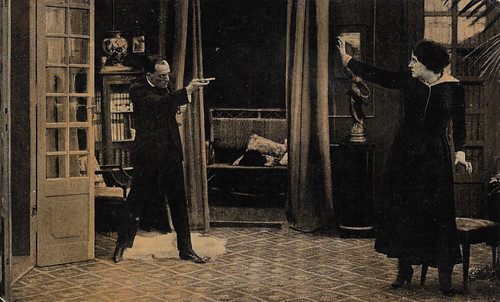
Spanish collectors card by Chocolate Pi, Barcelona, no. 6 of 6. Photo: Tiber Film. Hesperia and Emilio Ghione in Il potere sovrano (Baldassarre Negroni, Percy Nash, 1916).
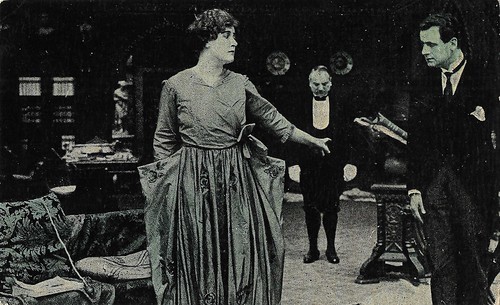
Spanish cromo card by Chocolate Pi, Barcelona, no. 2 of 6 cards. Photo: Tiber-Film, Roma / J. Verdaguer, Barcelona. Hesperia and Tullio Carminati in La donna abbandonata (Baldassarre Negroni, 1917).
A Parisian 'viveur' is fed of his life and withdraws to a family castle in the countryside. There he sees a mysterious lady, who leads a withdrawn life. Intrigued, he invents a ruse to meet her. She tells him her sorrowful past... The plot was based on a novella by Balzac, but the Italian press found the story too static and interiorised for the medium of film.
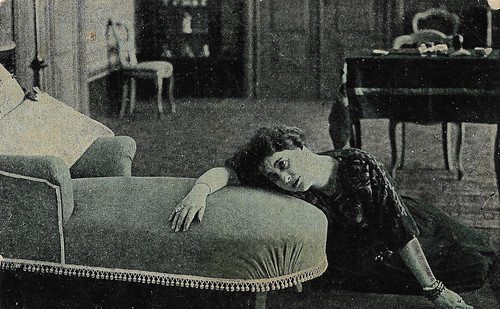
Spanish cromo card by Chocolate Pi, Barcelona, no. 4 of 6 cards. Photo: Tiber-Film, Roma / J. Verdaguer, Barcelona. Hesperia in La donna abbandonata (Baldassarre Negroni, 1917).
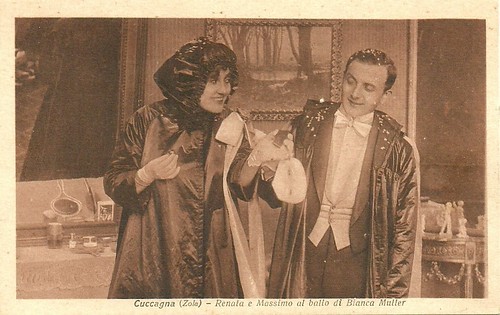
Italian postcard, no. 5073. Photo: Tiber Film. Hesperia and Alberto Collo in La cuccagna (Baldassarre Negroni, 1917). Caption: Renata and Massimo at the ball of Bianca Muller.
La cuccagna was an adaptation of Emile Zola's 'La curée'. Hesperia is Renata/Renée, second wife of the cunning and wealthy Saccard, who married young Renata for her money. She has an affair with Saccard's son Max/Massimo, played by Alberto Collo . In the end money triumphs instead of love, just as in Zola's novel.
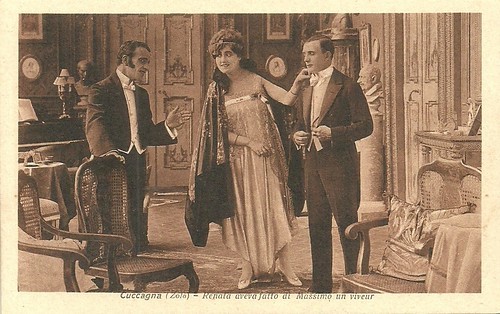
Italian postcard, no. 5077. Photo: Tiber Film. Hesperia in La cuccagna (Baldassarre Negroni, 1917). Caption: Renata had turned Massimo in an 'viveur'.
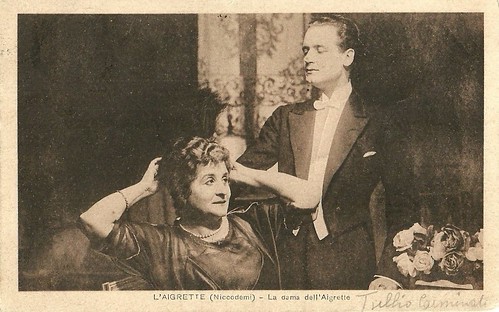
Italian postcard by IPA CT Duplex, no. 5103. photo: Tiber Film, Roma. Tullio Carminati and Ida Carloni Talli in L'aigrette (Baldassarre Negroni, 1917).
The countess of Saint-Servant ( Ida Carloni Talli ) has raised her son Enrico ( Tullio Carminati ) to be proud of his name and title and to cherish honour and virtue, symbolised by the feather of her aigrette (egret). In reality, the countess is hunted by creditors, the castle is falling apart. Enrico falls in love with Susanne Leblanc ( Hesperia ), wife of a banker, and, unknowing to Enrico, in return, she loads his mother with money in order to restore the family castle and pay off the many debts. Her husband Claudio ( André Habay ) is not so happy with this kind of charity and reveals to Enrico that he and his mother have been living on his lover's expenses for years...
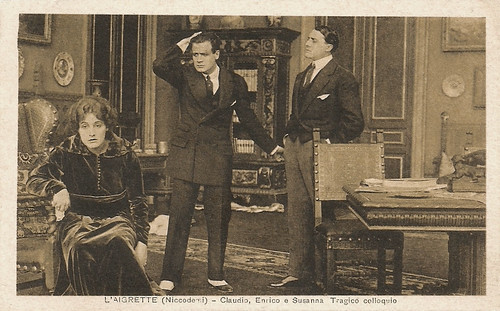
Italian postcard by IPA CT Duplex, no. 5108. Photo: Tiber Film, Hesperia , Tullio Carminati and André Habay in L'aigrette (Baldassarre Negroni, 1917). Caption: Claudio, Enrico, and Susanna. Tragic conversation.
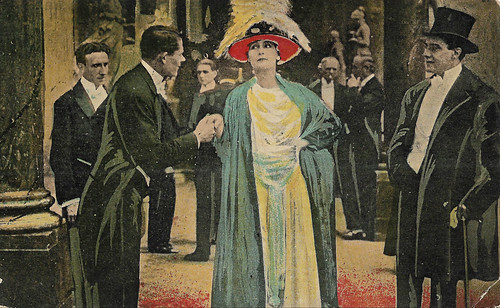
Spanish collectors card in the Colec. cromos cinematográficos by Chocolat Imperiale, no. 1 (in a serie of 6 cromos). Photo: Tiber-Film, Roma / J. Verdaguer, Barcelona. Hesperia and André Habay in La principessa di Bagdad (Baldassarre Negroni, 1918).
Lionella ( Hesperia ) is the illegitimate daughter of the King of Bagdad, and recognized by her stepfather, the count of Quansas. Raised a spoiled brat, when she marries the Count Giovanni de Hun ( André Habay ), she squanders his richness lightly. A family friend, Nourmandy (Goffredo d'Andrea), secretly in love with Lionella, pays all debts. De Hun believes his wife and Nourmandy are lovers, so he has them arrested by the police just when she is refusing another offer by Nourmandy. Hurt in her pride by her husband's brutal behavior, Lionella decides to leave with her lover, but her little son Raul begs her to refrain from such a step. Lionella's motherly love is bigger than her pride, so she chases the lover and pays off the debts with a generous donation by the dying, and repenting King. Her husband, at last, understands everything.
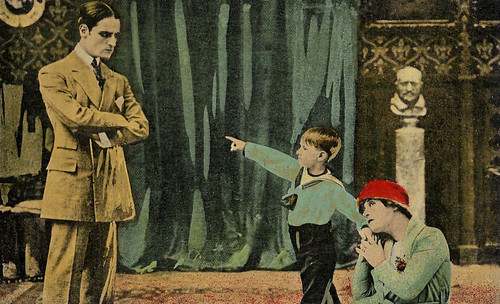
Spanish collectors card in the Colec. cromos cinematográficos by Chocolat Imperiale, no. 5 (in a serie of 6 cromos). Photo: Tiber-Film, Roma / J. Verdaguer, Barcelona. Hesperia in La principessa di Bagdad (Baldassarre Negroni, 1918).
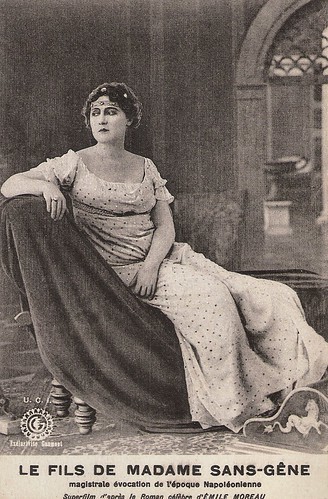
French postcard by Le Deley, Paris. Photo: U.C.I. / Gaumont / Tiber Film. Hesperia in Il figlio di Madame Sans-Gêne (Baldassarre Negroni, 1921), adapted from the novel by Emile Moreau. Here Hesperia as Madame Sans-Gêne is portrayed similarly to François Gérard's portrait of Juliette Récamier.
In Il figlio di Madame Sans-Gêne , sergeant Lefèvre (Enrico Scatizzi) meets an ironing lady ( Hesperia ) at a 'bal populaire' during the celebrations of the first successes of the French Revolution. They marry and have a son, Antonio. Lefèvre proves himself on the European battlefields and he becomes Marshal and Duke of Danzig. His wife becomes Madame Sans-Gêne, Duchess of Danzig. When Antonio (Carlo Troisi) has grown up, he falls in love with a young noble lady (Pauline Polaire), but she is already promised to the seigneur Ambzac, a Royalist conspirator. When the girl marries D'Ambzac, Antonio decides to flee with her and steals money from his father. When the theft is found out, Antonio asks to be sent to the battlefront as punishment.
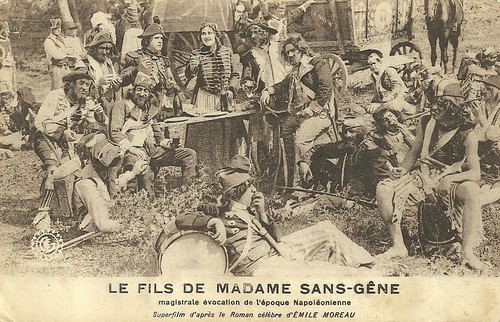
French postcard by Le Deley, Paris. Photo: U.C.I. / Gaumont / Tiber Film. Hesperia in Il figlio di Madame Sans-Gêne (Baldassarre Negroni, 1921).
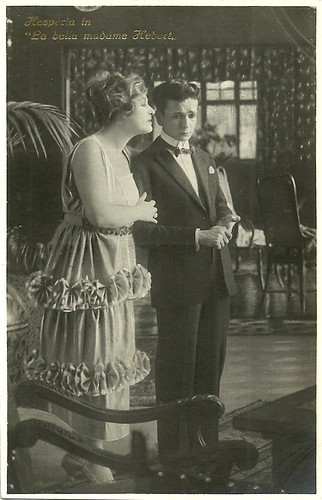
Italian postcard. Photo: Tiber Film. Hesperia and probably Carlo Troisi in La belle Madame Hebert (Baldassarre Negroni, 1922). The film was an adaptation of the homonymous French play by Abel Hermant.
Diva Dramas and Propaganda films
Before he started Tiber Film, Gioacchino Mecheri had been the director of the Celio company. Tiber Film had its Roman studios at the Pineta Sacchetti.
Tiber Film was known for its diva dramas with Hesperia , such as Il potere sovrano/The Sovereign Power (1916), La cuccagna/The Bonanza (1917), L'aigrette/The Egret (1917), La principessa di Bagdad/The Princess of Bagdad (1918), Il figlio di Madame Sans-Gêne/The Son of Madame Sans-Gêne (1921), and La belle Madame Hebért (1922). Most of these dramas were directed by Hesperia's husband, Baldassarre Negroni.
In addition to these Diva films, Tiber Film profiled itself also with historical films serving the war propaganda. These films included Oberdan/Guglielmo Oberdan, il martire di Trieste (Emilio Ghione, 1915), and Cicueracchio (Emilio Ghione, 1915).
The studio also produced melodramas with Maria Jacobini such as Come le foglie/Like the leafs (Gennaro Righelli, 1917), and Resurrezione/Resurrection (Mario Caserini, 1917) and with Diana Karenne , like La peccatrice casta/The chaste sinner (Diana Karenne, Gennaro Righelli, 1919) and Zoya (Giulio Antamoro, 1920).
Tiber also produced the Polidor and Za-la-Mort films, including I topi grigi/The gray mice (Emilio Ghione, 1918), starring Emilio Ghione .
In 1918 the company merged with Film d'Arte Italiana and in 1919 with the Unione Cinematografia Italiana (UCI). When the latter collapsed in 1923, this also meant the end of Tiber Film.
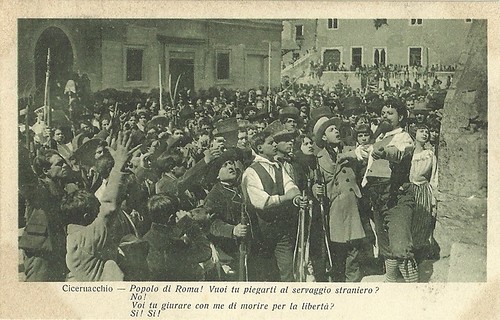
Italian postcard. Photo: Tiber Film. Gastone Monaldi as Ciceruacchio in Ciceruacchio (Emilio Ghione, 1915). Caption: People of Rome! Do you want to bend to slavery by the stranger? No! Do you want to swear with me to die for freedom? Yes! Yes!
Angelo Brunetti, named Ciceruacchio, a Roman trader in cheese and wine, was much beloved by the Roman people, e.g. for his behaviour during the 1837 cholera plague. In a public performance in 1846, he thanked the pope Pius IX for releasing political prisoners, while in 1847 he pressed Pius IX to continue his policy of reform. During the 1848 revolution, he joined the Roman Republican forces and helped the Romans in the siege by the French. But when they were defeated in 1849, he fled with his sons Lorenzo and Luigi and hoped with Garibaldi and allies to liberate Venice from the Austrians. Instead, they were betrayed by locals at Cesenatico and then arrested and executed by the Austrians on 10 August 1849.
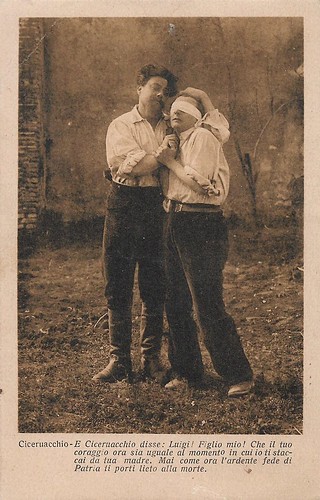
Italian postcard. Photo: Tiber Film. Gastone Monaldi as Ciceruacchio and Alberto Collo as his son Luigi, just before they are executed by the Austrian army in Ciceruacchio (Emilio Ghione, 1915). Caption: And Ciceruacchio said: Luigi, my son! Let your courage at this moment be the same as when I separated you from your mother. Like never before, the ardent faith of the fatherland will bring you happily to your death.
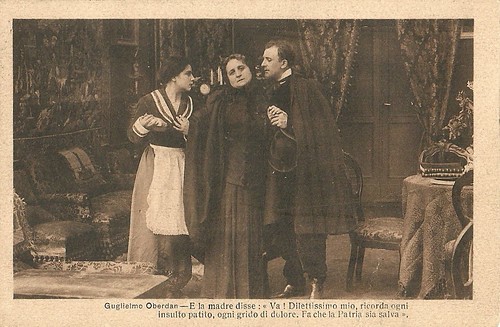
Italian postcard. Photo: Tiber Film. Alberto Collo as Oberdan, and Ida Carloni Talli as his mother in Guglielmo Oberdan, il martire di Trieste (Emilio Ghione 1915). Caption: And his mother said: Go! My most beloved one, remember every suffered insult, every cry of grief. Make sure that the Fatherland will be saved.
In 1882, Guglielmo Oberdan was executed after a failed attempt to assassinate Austrian Emperor Francis Joseph. He became a martyr of the Italian unification movement. Thirty years later, silent film star Alberto Collo played him in Guglielmo Oberdan, il martire di Trieste (Emilio Ghione, 1915), produced by Tiber Films during World War I.
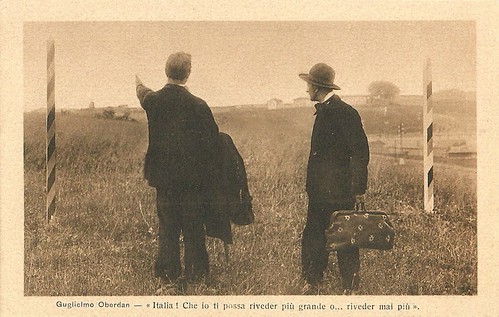
Italian postcard. Photo: Tiber Film. Alberto Collo in Guglielmo Oberdan, il martire di Trieste (Emilio Ghione, 1915). Caption: Italy! May I see you again having grown bigger... or never see you again.
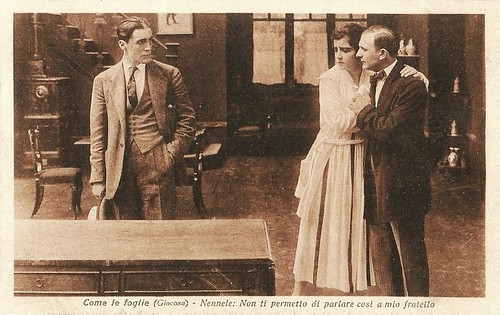
Italian postcard. Photo: Tiber Film, Roma. Guido Guiducci as Massimo, Maria Jacobini as Nennele and Alberto Collo as her brother Tommy in Come le foglie (Gennaro Righelli, 1917). Caption: I won't allow you to speak about my brother in this way.
After a life of spendthrifts, the Rosati (Rosani with Giacosa) family is ruined. Father Giovanni ( Ignazio Lupi ) accepts work from his cousin Massimo (Guido Guiducci) in Switzerland. Hitherto neglected as too serious and workaholic, Massimo becomes the head of the family and takes care of the son and daughter of Giovanni, Tommy ( Alberto Collo ) and Nennele ( Maria Jacobini ), and their stepmother Giulia (Floriana). Tommy and Giulia remain weak spirits. Giulia has an affair with a painter called Helmer, and when none of her own paintings are sold, she tries to steal the golden frame from one of Nennele's paintings. Tommy's idleness is like a dead leaf. He fails two managing jobs arranged by Massimo. Because of his gambling debts with the Russian countess Orloff's gambling table, he is forced to marry her. Massimo proposes to Nennele, advising her not to rebel 'against the wind that blows the leaves', but she refuses him. She is so devastated by her brother and stepmother, she intends to commit suicide, but her father prevents this and unites Nennele with Massimo, who has come to help once more.
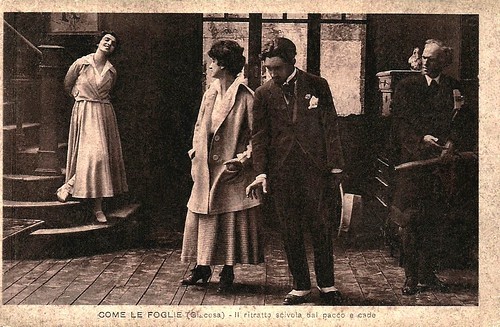
Italian postcard. Photo: Tiber Film, Roma. Maria Jacobini in Come le foglie (Gennaro Righelli, 1917). The man in the middle could be Alberto Collo . Caption: The portrait slipped from the package and fell to the ground.
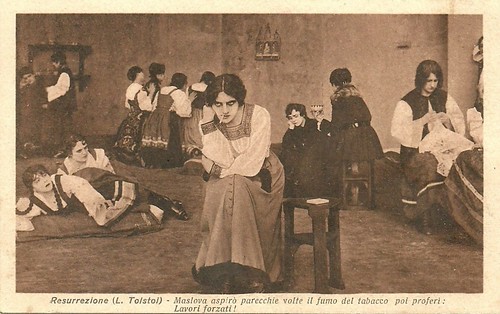
Italian postcard. Photo: Tiber Film. Maria Jacobini in Resurrezione (Mario Caserini, 1917), based on Leo Tolstoy's novel. Caption: Maslova inhaled the tobacco's smoke a few times, then uttered: Forced labour!
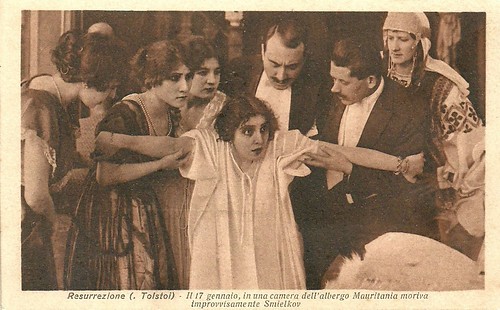
Italian postcard. Photo: Tiber Film. Maria Jacobini in Resurrezione (Mario Caserini, 1917), based on Leo Tolstoy's novel. Caption: On 17 January in a room of Hotel Mauritania, Smielkov suddenly died.
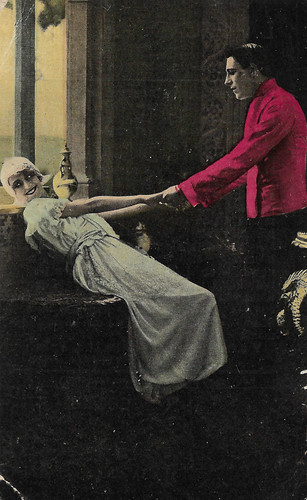
Spanish cromo by Chocolat Imperiale, Barcelona, no. 3 of 6. Photo: Tiber Film / Verdaguer. Diana Karenne and Alberto Pasquali in La peccatrice casta (Diana Karenne, Gennaro Righelli, 1919).
Wanda ( Diana Karenne ) is a popular dancer, but very ill. When she collapses during a performance, a count ( Alberto Pasquali ), comes to aid, falls in love with her, and wants to marry her. Wanda accepts but after the wedding she returns to dancing and her mundane life starts again, which she never could say goodbye to. She ends up falling for another man ( Mario Parpagnoli ), while her husband, after finding out, bitterly leaves for the US. One year after, the husband returns and finds her alone, with a child, and left by her lover. He reunites with her, pardons her, and accepts the child too.
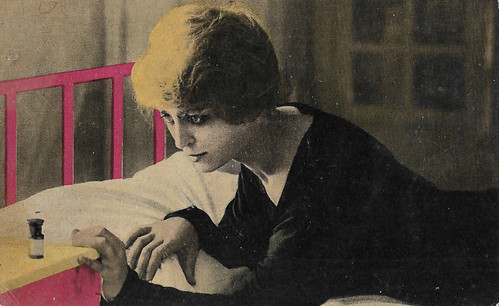
Spanish cromo by Chocolat Imperiale, Barcelona, no. 6 of 6. Photo: Tiber Film / Verdaguer. Diana Karenne in La peccatrice casta (Diana Karenne, Gennaro Righelli, 1919).
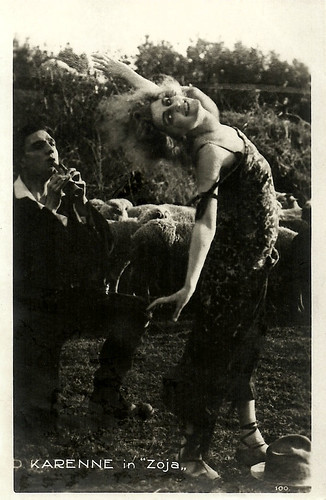
Italian postcard by Vettori, Bologna. Photo: Tiber Film. Diana Karenne in Zoya/Zoja (Giulio Antamoro, 1920). The man left might be Mario Parpagnoli .
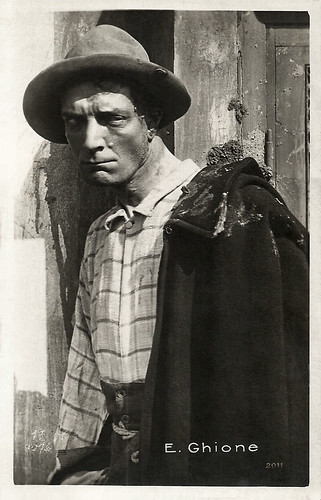
Italian postcard by Vettori, Bologna, no. 2011. Photo: Tiber Film / U.C.I. Emilio Ghione in Senza pietà (Emilio Ghione, 1921).
Sources: Vittorio Martinelli (Il cinema muto italiano, Vol. 1915, 1916, 1917, 1918, 1921-22), Vittorio Martinelli (Za la Mort. Ritratto di Emilio Ghione), and Wikipedia (Italian).

Spanish collectors card by Chocolate Pi, Barcelona, no. 2 of 6. Photo: Tiber Film. Hesperia and Emilio Ghione in Il potere sovrano (Baldassarre Negroni, Percy Nash, 1916).
Il potere sovrano was based on the novel 'Temporal Power' by Marie Corelli. Lotys ( Hesperia ) is the idol of the people. Therd ( Emilio Ghione ), a journalist, a man of action, and manager of the paper The Idea, is also beloved by his compatriots. Their ideals unite Lotys and Therd. The King ( Ignazio Lupi ) lives distanced from his people and has left governing to his ministers. The government threatens Therd with arrest if he doesn't stop his actions.

Spanish collectors card by Chocolate Pi, Barcelona, no. 6 of 6. Photo: Tiber Film. Hesperia and Emilio Ghione in Il potere sovrano (Baldassarre Negroni, Percy Nash, 1916).

Spanish cromo card by Chocolate Pi, Barcelona, no. 2 of 6 cards. Photo: Tiber-Film, Roma / J. Verdaguer, Barcelona. Hesperia and Tullio Carminati in La donna abbandonata (Baldassarre Negroni, 1917).
A Parisian 'viveur' is fed of his life and withdraws to a family castle in the countryside. There he sees a mysterious lady, who leads a withdrawn life. Intrigued, he invents a ruse to meet her. She tells him her sorrowful past... The plot was based on a novella by Balzac, but the Italian press found the story too static and interiorised for the medium of film.

Spanish cromo card by Chocolate Pi, Barcelona, no. 4 of 6 cards. Photo: Tiber-Film, Roma / J. Verdaguer, Barcelona. Hesperia in La donna abbandonata (Baldassarre Negroni, 1917).

Italian postcard, no. 5073. Photo: Tiber Film. Hesperia and Alberto Collo in La cuccagna (Baldassarre Negroni, 1917). Caption: Renata and Massimo at the ball of Bianca Muller.
La cuccagna was an adaptation of Emile Zola's 'La curée'. Hesperia is Renata/Renée, second wife of the cunning and wealthy Saccard, who married young Renata for her money. She has an affair with Saccard's son Max/Massimo, played by Alberto Collo . In the end money triumphs instead of love, just as in Zola's novel.

Italian postcard, no. 5077. Photo: Tiber Film. Hesperia in La cuccagna (Baldassarre Negroni, 1917). Caption: Renata had turned Massimo in an 'viveur'.

Italian postcard by IPA CT Duplex, no. 5103. photo: Tiber Film, Roma. Tullio Carminati and Ida Carloni Talli in L'aigrette (Baldassarre Negroni, 1917).
The countess of Saint-Servant ( Ida Carloni Talli ) has raised her son Enrico ( Tullio Carminati ) to be proud of his name and title and to cherish honour and virtue, symbolised by the feather of her aigrette (egret). In reality, the countess is hunted by creditors, the castle is falling apart. Enrico falls in love with Susanne Leblanc ( Hesperia ), wife of a banker, and, unknowing to Enrico, in return, she loads his mother with money in order to restore the family castle and pay off the many debts. Her husband Claudio ( André Habay ) is not so happy with this kind of charity and reveals to Enrico that he and his mother have been living on his lover's expenses for years...

Italian postcard by IPA CT Duplex, no. 5108. Photo: Tiber Film, Hesperia , Tullio Carminati and André Habay in L'aigrette (Baldassarre Negroni, 1917). Caption: Claudio, Enrico, and Susanna. Tragic conversation.

Spanish collectors card in the Colec. cromos cinematográficos by Chocolat Imperiale, no. 1 (in a serie of 6 cromos). Photo: Tiber-Film, Roma / J. Verdaguer, Barcelona. Hesperia and André Habay in La principessa di Bagdad (Baldassarre Negroni, 1918).
Lionella ( Hesperia ) is the illegitimate daughter of the King of Bagdad, and recognized by her stepfather, the count of Quansas. Raised a spoiled brat, when she marries the Count Giovanni de Hun ( André Habay ), she squanders his richness lightly. A family friend, Nourmandy (Goffredo d'Andrea), secretly in love with Lionella, pays all debts. De Hun believes his wife and Nourmandy are lovers, so he has them arrested by the police just when she is refusing another offer by Nourmandy. Hurt in her pride by her husband's brutal behavior, Lionella decides to leave with her lover, but her little son Raul begs her to refrain from such a step. Lionella's motherly love is bigger than her pride, so she chases the lover and pays off the debts with a generous donation by the dying, and repenting King. Her husband, at last, understands everything.

Spanish collectors card in the Colec. cromos cinematográficos by Chocolat Imperiale, no. 5 (in a serie of 6 cromos). Photo: Tiber-Film, Roma / J. Verdaguer, Barcelona. Hesperia in La principessa di Bagdad (Baldassarre Negroni, 1918).

French postcard by Le Deley, Paris. Photo: U.C.I. / Gaumont / Tiber Film. Hesperia in Il figlio di Madame Sans-Gêne (Baldassarre Negroni, 1921), adapted from the novel by Emile Moreau. Here Hesperia as Madame Sans-Gêne is portrayed similarly to François Gérard's portrait of Juliette Récamier.
In Il figlio di Madame Sans-Gêne , sergeant Lefèvre (Enrico Scatizzi) meets an ironing lady ( Hesperia ) at a 'bal populaire' during the celebrations of the first successes of the French Revolution. They marry and have a son, Antonio. Lefèvre proves himself on the European battlefields and he becomes Marshal and Duke of Danzig. His wife becomes Madame Sans-Gêne, Duchess of Danzig. When Antonio (Carlo Troisi) has grown up, he falls in love with a young noble lady (Pauline Polaire), but she is already promised to the seigneur Ambzac, a Royalist conspirator. When the girl marries D'Ambzac, Antonio decides to flee with her and steals money from his father. When the theft is found out, Antonio asks to be sent to the battlefront as punishment.

French postcard by Le Deley, Paris. Photo: U.C.I. / Gaumont / Tiber Film. Hesperia in Il figlio di Madame Sans-Gêne (Baldassarre Negroni, 1921).

Italian postcard. Photo: Tiber Film. Hesperia and probably Carlo Troisi in La belle Madame Hebert (Baldassarre Negroni, 1922). The film was an adaptation of the homonymous French play by Abel Hermant.
Diva Dramas and Propaganda films
Before he started Tiber Film, Gioacchino Mecheri had been the director of the Celio company. Tiber Film had its Roman studios at the Pineta Sacchetti.
Tiber Film was known for its diva dramas with Hesperia , such as Il potere sovrano/The Sovereign Power (1916), La cuccagna/The Bonanza (1917), L'aigrette/The Egret (1917), La principessa di Bagdad/The Princess of Bagdad (1918), Il figlio di Madame Sans-Gêne/The Son of Madame Sans-Gêne (1921), and La belle Madame Hebért (1922). Most of these dramas were directed by Hesperia's husband, Baldassarre Negroni.
In addition to these Diva films, Tiber Film profiled itself also with historical films serving the war propaganda. These films included Oberdan/Guglielmo Oberdan, il martire di Trieste (Emilio Ghione, 1915), and Cicueracchio (Emilio Ghione, 1915).
The studio also produced melodramas with Maria Jacobini such as Come le foglie/Like the leafs (Gennaro Righelli, 1917), and Resurrezione/Resurrection (Mario Caserini, 1917) and with Diana Karenne , like La peccatrice casta/The chaste sinner (Diana Karenne, Gennaro Righelli, 1919) and Zoya (Giulio Antamoro, 1920).
Tiber also produced the Polidor and Za-la-Mort films, including I topi grigi/The gray mice (Emilio Ghione, 1918), starring Emilio Ghione .
In 1918 the company merged with Film d'Arte Italiana and in 1919 with the Unione Cinematografia Italiana (UCI). When the latter collapsed in 1923, this also meant the end of Tiber Film.

Italian postcard. Photo: Tiber Film. Gastone Monaldi as Ciceruacchio in Ciceruacchio (Emilio Ghione, 1915). Caption: People of Rome! Do you want to bend to slavery by the stranger? No! Do you want to swear with me to die for freedom? Yes! Yes!
Angelo Brunetti, named Ciceruacchio, a Roman trader in cheese and wine, was much beloved by the Roman people, e.g. for his behaviour during the 1837 cholera plague. In a public performance in 1846, he thanked the pope Pius IX for releasing political prisoners, while in 1847 he pressed Pius IX to continue his policy of reform. During the 1848 revolution, he joined the Roman Republican forces and helped the Romans in the siege by the French. But when they were defeated in 1849, he fled with his sons Lorenzo and Luigi and hoped with Garibaldi and allies to liberate Venice from the Austrians. Instead, they were betrayed by locals at Cesenatico and then arrested and executed by the Austrians on 10 August 1849.

Italian postcard. Photo: Tiber Film. Gastone Monaldi as Ciceruacchio and Alberto Collo as his son Luigi, just before they are executed by the Austrian army in Ciceruacchio (Emilio Ghione, 1915). Caption: And Ciceruacchio said: Luigi, my son! Let your courage at this moment be the same as when I separated you from your mother. Like never before, the ardent faith of the fatherland will bring you happily to your death.

Italian postcard. Photo: Tiber Film. Alberto Collo as Oberdan, and Ida Carloni Talli as his mother in Guglielmo Oberdan, il martire di Trieste (Emilio Ghione 1915). Caption: And his mother said: Go! My most beloved one, remember every suffered insult, every cry of grief. Make sure that the Fatherland will be saved.
In 1882, Guglielmo Oberdan was executed after a failed attempt to assassinate Austrian Emperor Francis Joseph. He became a martyr of the Italian unification movement. Thirty years later, silent film star Alberto Collo played him in Guglielmo Oberdan, il martire di Trieste (Emilio Ghione, 1915), produced by Tiber Films during World War I.

Italian postcard. Photo: Tiber Film. Alberto Collo in Guglielmo Oberdan, il martire di Trieste (Emilio Ghione, 1915). Caption: Italy! May I see you again having grown bigger... or never see you again.

Italian postcard. Photo: Tiber Film, Roma. Guido Guiducci as Massimo, Maria Jacobini as Nennele and Alberto Collo as her brother Tommy in Come le foglie (Gennaro Righelli, 1917). Caption: I won't allow you to speak about my brother in this way.
After a life of spendthrifts, the Rosati (Rosani with Giacosa) family is ruined. Father Giovanni ( Ignazio Lupi ) accepts work from his cousin Massimo (Guido Guiducci) in Switzerland. Hitherto neglected as too serious and workaholic, Massimo becomes the head of the family and takes care of the son and daughter of Giovanni, Tommy ( Alberto Collo ) and Nennele ( Maria Jacobini ), and their stepmother Giulia (Floriana). Tommy and Giulia remain weak spirits. Giulia has an affair with a painter called Helmer, and when none of her own paintings are sold, she tries to steal the golden frame from one of Nennele's paintings. Tommy's idleness is like a dead leaf. He fails two managing jobs arranged by Massimo. Because of his gambling debts with the Russian countess Orloff's gambling table, he is forced to marry her. Massimo proposes to Nennele, advising her not to rebel 'against the wind that blows the leaves', but she refuses him. She is so devastated by her brother and stepmother, she intends to commit suicide, but her father prevents this and unites Nennele with Massimo, who has come to help once more.

Italian postcard. Photo: Tiber Film, Roma. Maria Jacobini in Come le foglie (Gennaro Righelli, 1917). The man in the middle could be Alberto Collo . Caption: The portrait slipped from the package and fell to the ground.

Italian postcard. Photo: Tiber Film. Maria Jacobini in Resurrezione (Mario Caserini, 1917), based on Leo Tolstoy's novel. Caption: Maslova inhaled the tobacco's smoke a few times, then uttered: Forced labour!

Italian postcard. Photo: Tiber Film. Maria Jacobini in Resurrezione (Mario Caserini, 1917), based on Leo Tolstoy's novel. Caption: On 17 January in a room of Hotel Mauritania, Smielkov suddenly died.

Spanish cromo by Chocolat Imperiale, Barcelona, no. 3 of 6. Photo: Tiber Film / Verdaguer. Diana Karenne and Alberto Pasquali in La peccatrice casta (Diana Karenne, Gennaro Righelli, 1919).
Wanda ( Diana Karenne ) is a popular dancer, but very ill. When she collapses during a performance, a count ( Alberto Pasquali ), comes to aid, falls in love with her, and wants to marry her. Wanda accepts but after the wedding she returns to dancing and her mundane life starts again, which she never could say goodbye to. She ends up falling for another man ( Mario Parpagnoli ), while her husband, after finding out, bitterly leaves for the US. One year after, the husband returns and finds her alone, with a child, and left by her lover. He reunites with her, pardons her, and accepts the child too.

Spanish cromo by Chocolat Imperiale, Barcelona, no. 6 of 6. Photo: Tiber Film / Verdaguer. Diana Karenne in La peccatrice casta (Diana Karenne, Gennaro Righelli, 1919).

Italian postcard by Vettori, Bologna. Photo: Tiber Film. Diana Karenne in Zoya/Zoja (Giulio Antamoro, 1920). The man left might be Mario Parpagnoli .

Italian postcard by Vettori, Bologna, no. 2011. Photo: Tiber Film / U.C.I. Emilio Ghione in Senza pietà (Emilio Ghione, 1921).
Sources: Vittorio Martinelli (Il cinema muto italiano, Vol. 1915, 1916, 1917, 1918, 1921-22), Vittorio Martinelli (Za la Mort. Ritratto di Emilio Ghione), and Wikipedia (Italian).
Published on July 31, 2020 22:00
July 30, 2020
Sally Eilers
American actress Sally Eilers (1908-1978) was a popular Hollywood star in the early-1930s. She was tagged 'the most beautiful girl in movies'.
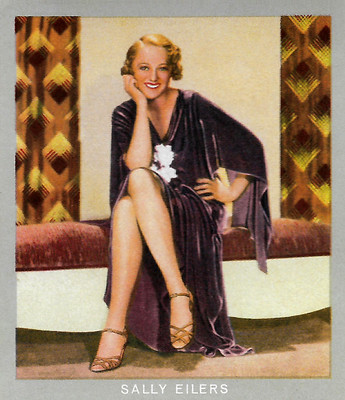
German cigarette card by Ross Verlag in the 'Künstler im Film' series for Zigarettenfabrik Monopol, Dresden, Serie 1, image 116 (of 200). Photo: Fox-Film.
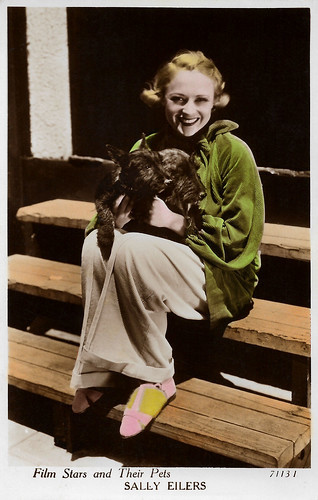
British postcard by Valentine's in the Film Stars and Their Pets series, no. 71131. Photo: Fox.
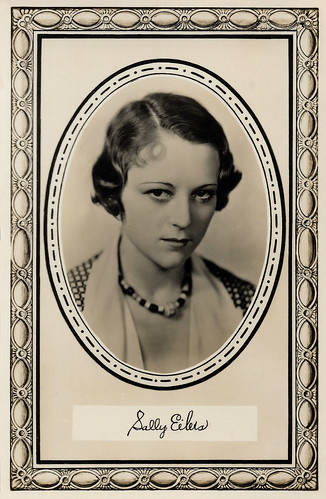
British 'Real Photograph' postcard in the Autograph Series, London, no. A 30.
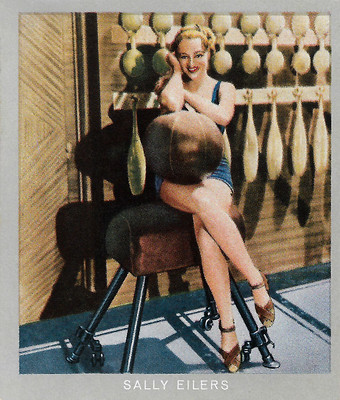
German cigarette card by Ross Verlag in the 'Künstler im Film' series for Zigarettenfabrik Monopol, Dresden, Serie 1, image 104 (of 200). Photo: 20th Century Fox.
The vivacious former brunette
Dorothea Sally Eilers was born in New York City in 1908 to a Jewish-American mother, Paula (née Schoenberger), and an Irish-American father, Hio Peter Eilers, who was an inventor.
She was educated in Los Angeles, California, and went into films because so many of her friends were in pictures. She studied for the stage, specialising in dancing. Her first try was a failure so she tried typing but then went back into pictures and succeeded.
She made her film debut with an uncredited bit part in the comedy The Red Mill (Roscoe Arbuckle as William Goodrich, 1927) with Marion Davies . After several minor roles as an extra, she found work with Mack Sennett. In 1927, he offered her a role in The Good-Bye Kiss (Mack Sennett, 1928), a rare dramatic feature for the studio.
Either Sennett or Florenz Ziegfeld Jr. (depending on which version of the story is to be believed) tagged Sally with the publicity line 'the most beautiful girl in movies'. In 1928 she was voted as one of the WAMPAS Baby Stars, a yearly list of young actresses nominated by exhibitors based on their box-office appeal.
The vivacious former brunette (quickly transformed by Hollywood into a blonde) spent her apprenticeship as a leading actress co-starring with her future husband Hoot Gibson in the Western The Long, Long Trail (Arthur Rosson, 1929) and with Buster Keaton in the comedy Doughboys (Edward Sedgwick, 1930).
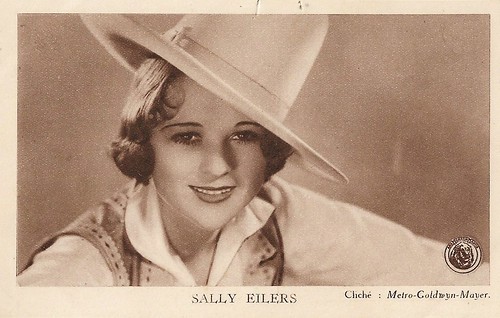
Belgian postcard by S.A. Cacao et Chocolat Kivou, Vilvoorde / N.V. Cacao en Chocolade Kivou, Vilvoorde. Photo: Metro-Goldwyn-Mayer.
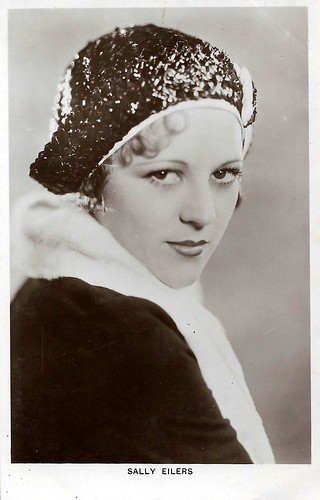
British postcard in the Picturegoer Series, London, no. 558.
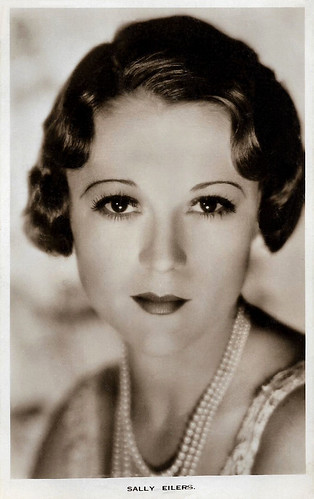
British postcard in the Film Weekly Series, no. 1.
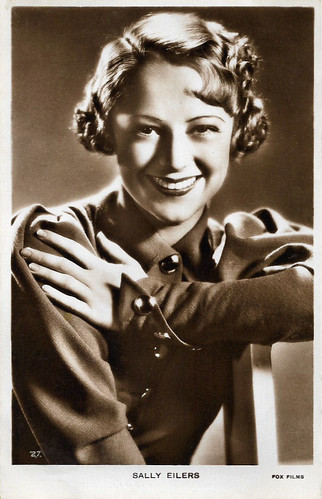
British Real Photograph postcard, no. 27. Photo: Fox Films.
Known for her high spirits and vivacity
Sally Eilers became a popular figure in the early-1930s Hollywood, known for her high spirits and vivacity. In 1931, director Frank Borzage cast her in the depression-era film Bad Girl (1931).
I.S. Mowis at IMDb : "What could have been maudlin melodrama, was enlivened by excellent direction and some snappy dialogue (winning Academy Awards for both direction and screenplay) and elicited from Sally Eilers in the title role (as 'Dot Haley') the best performance of her career. There were to be other films of note: Reducing (1931) with Marie Dressler, the original State Fair (1933) with Will Rogers (with Sally playing a 'carnie') and Sailor's Luck (1933), with her Bad Girl (1931) co-star James Dunn, where a review described her performance as 'highly satisfactory'."
Her other films were mostly comedies and crime melodramas such as the crime film Quick Millions (Rowland Browne, 1931) with Spencer Tracy and the sparkling mystery comedy Remember Last Night? (James Whale, 1935).
She was married for a short time to cowboy actor Hoot Gibson , though the marriage ended in divorce in 1933. By the end of the decade, her popularity had waned, and her subsequent film appearances were few. She made her final film appearance in 1950.
She was married four times. With her second husband, Harry Joe Brown, she resided in a mansion located in Beverly Hills. They had a son, screenwriter Harry Joe Brown Jr. Her other two husbands were Howard Barney and director Hollingsworth Morse.
During her final years, Sally Eilers suffered poor health, and died from a heart attack in 1978, in Woodland Hills, California. She was 69.
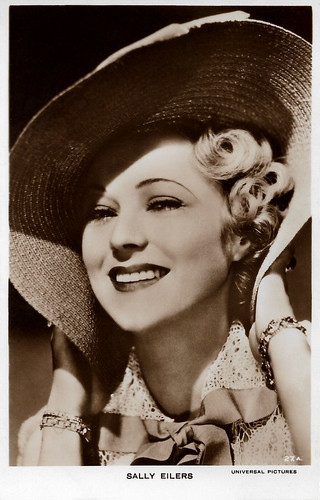
British postcard by Milton, no. 27A. Photo: Universal Pictures.
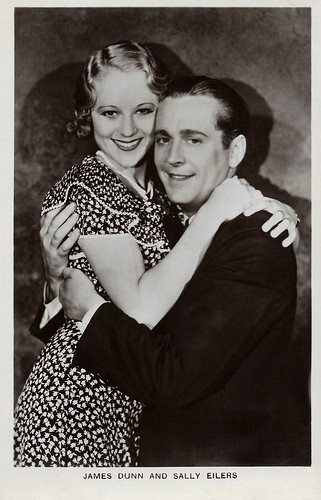
British postcard in the Film Partners Series, London, no. P 12. Photo: Sally Eilers and James Dunn in Bad Girl (Frank Borzage, 1931).
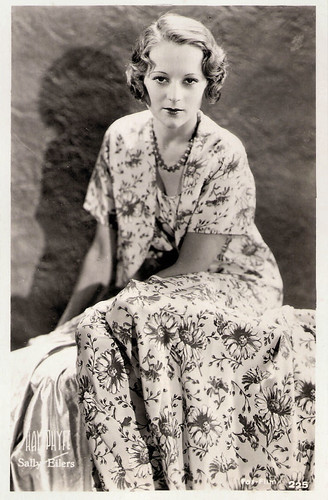
Dutch postcard, no. 25. Photo: Hal Phyfe / Fox Film.
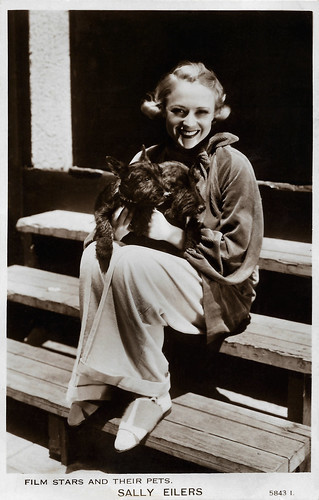
British postcard by Valentine's in the Film Stars and Their Pets series, no. 5843 I. Photo: Fox. Sent by mail in 1934.
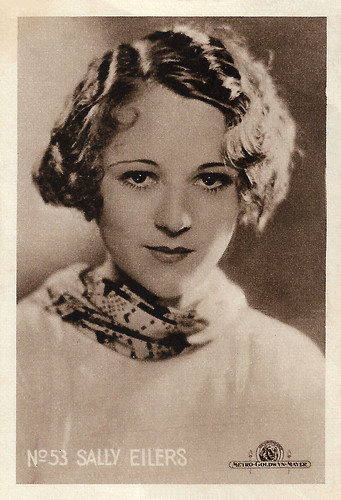
Dutch-Belgian collectors card by N.V. London Caramel Works, Breda (Holland) / Esschen (België), no. 53 (of 120). Photo: Metro-Goldwyn-Mayer.
Sources: (IMDb), Wikipedia, and .

German cigarette card by Ross Verlag in the 'Künstler im Film' series for Zigarettenfabrik Monopol, Dresden, Serie 1, image 116 (of 200). Photo: Fox-Film.

British postcard by Valentine's in the Film Stars and Their Pets series, no. 71131. Photo: Fox.

British 'Real Photograph' postcard in the Autograph Series, London, no. A 30.

German cigarette card by Ross Verlag in the 'Künstler im Film' series for Zigarettenfabrik Monopol, Dresden, Serie 1, image 104 (of 200). Photo: 20th Century Fox.
The vivacious former brunette
Dorothea Sally Eilers was born in New York City in 1908 to a Jewish-American mother, Paula (née Schoenberger), and an Irish-American father, Hio Peter Eilers, who was an inventor.
She was educated in Los Angeles, California, and went into films because so many of her friends were in pictures. She studied for the stage, specialising in dancing. Her first try was a failure so she tried typing but then went back into pictures and succeeded.
She made her film debut with an uncredited bit part in the comedy The Red Mill (Roscoe Arbuckle as William Goodrich, 1927) with Marion Davies . After several minor roles as an extra, she found work with Mack Sennett. In 1927, he offered her a role in The Good-Bye Kiss (Mack Sennett, 1928), a rare dramatic feature for the studio.
Either Sennett or Florenz Ziegfeld Jr. (depending on which version of the story is to be believed) tagged Sally with the publicity line 'the most beautiful girl in movies'. In 1928 she was voted as one of the WAMPAS Baby Stars, a yearly list of young actresses nominated by exhibitors based on their box-office appeal.
The vivacious former brunette (quickly transformed by Hollywood into a blonde) spent her apprenticeship as a leading actress co-starring with her future husband Hoot Gibson in the Western The Long, Long Trail (Arthur Rosson, 1929) and with Buster Keaton in the comedy Doughboys (Edward Sedgwick, 1930).

Belgian postcard by S.A. Cacao et Chocolat Kivou, Vilvoorde / N.V. Cacao en Chocolade Kivou, Vilvoorde. Photo: Metro-Goldwyn-Mayer.

British postcard in the Picturegoer Series, London, no. 558.

British postcard in the Film Weekly Series, no. 1.

British Real Photograph postcard, no. 27. Photo: Fox Films.
Known for her high spirits and vivacity
Sally Eilers became a popular figure in the early-1930s Hollywood, known for her high spirits and vivacity. In 1931, director Frank Borzage cast her in the depression-era film Bad Girl (1931).
I.S. Mowis at IMDb : "What could have been maudlin melodrama, was enlivened by excellent direction and some snappy dialogue (winning Academy Awards for both direction and screenplay) and elicited from Sally Eilers in the title role (as 'Dot Haley') the best performance of her career. There were to be other films of note: Reducing (1931) with Marie Dressler, the original State Fair (1933) with Will Rogers (with Sally playing a 'carnie') and Sailor's Luck (1933), with her Bad Girl (1931) co-star James Dunn, where a review described her performance as 'highly satisfactory'."
Her other films were mostly comedies and crime melodramas such as the crime film Quick Millions (Rowland Browne, 1931) with Spencer Tracy and the sparkling mystery comedy Remember Last Night? (James Whale, 1935).
She was married for a short time to cowboy actor Hoot Gibson , though the marriage ended in divorce in 1933. By the end of the decade, her popularity had waned, and her subsequent film appearances were few. She made her final film appearance in 1950.
She was married four times. With her second husband, Harry Joe Brown, she resided in a mansion located in Beverly Hills. They had a son, screenwriter Harry Joe Brown Jr. Her other two husbands were Howard Barney and director Hollingsworth Morse.
During her final years, Sally Eilers suffered poor health, and died from a heart attack in 1978, in Woodland Hills, California. She was 69.

British postcard by Milton, no. 27A. Photo: Universal Pictures.

British postcard in the Film Partners Series, London, no. P 12. Photo: Sally Eilers and James Dunn in Bad Girl (Frank Borzage, 1931).

Dutch postcard, no. 25. Photo: Hal Phyfe / Fox Film.

British postcard by Valentine's in the Film Stars and Their Pets series, no. 5843 I. Photo: Fox. Sent by mail in 1934.

Dutch-Belgian collectors card by N.V. London Caramel Works, Breda (Holland) / Esschen (België), no. 53 (of 120). Photo: Metro-Goldwyn-Mayer.
Sources: (IMDb), Wikipedia, and .
Published on July 30, 2020 22:00
Paul van Yperen's Blog
- Paul van Yperen's profile
- 13 followers
Paul van Yperen isn't a Goodreads Author
(yet),
but they
do have a blog,
so here are some recent posts imported from
their feed.



